Historical Society Page Additions - page 2
A Country Teacher’s Diary - 1905
Lewis F. Allen
"Playday" on Grand Island Celebrates End Of WWII, V-J Day - August 1945
Island's Original Bridges Are 70 Years Old This Week
Bedell House Saloon - Grand Island, New York
Isle Taverns Of The Good Old Days, Grand Island, NY
Army’s Nike Guided Missile Antiaircraft Battery Near Completion - Grand Island, NY
Grand Island's Points As UNO Site Listed
A Story of Grand Island/Niagara River Treasure
'Living Water' Of Indians Dies
The Best Niagara River Boating Days Are Gone, But the Stories Remain - 1951
Single Stack Side-wheeler Corona Burned At Edgewater, Grand Island, NY in 1898
Murder Of Well Known Reclusive Farmer Made Headlines 50 Years Ago
The George Bell House: 150 Years of History
Remembering Back 30 Years To The Blizzard Of ‘77
Army’s Nike Guided Missile Antiaircraft Battery Near Completion - Grand Island, NY
Published in the Island Dispatch - September 26, 1956 - No Author
Posted By Teddy Linenfelser on November 16, 2006
The Army’s Nike guided missile program in this area is beginning to take shape after more than two years of intensive construction and planning.
At one time, curious residents were asking antiaircraft officers, “What happens to the man riding in the missile?” Since that time, however, the lid of secrecy on the supersonic weapon has been largely removed. Western New Yorkers have grown to accept Nike as a vita component of the area air defense setup.
Guided missile sites at Model City and Cambria Center in Niagara County and on Grand Island in Erie County already are “operational.” Sites near Millersport, East Aurora and Hamburg are expected to be finished by the end of the year. A seventh site in the Town of Lancaster is scheduled for completion during 1957.
“Beautification” programs now are under way at the Model City, Cambria and Grand Island sites. This includes landscaping and the planting of trees and shrubs.
According to recently released Department of Defense reports, the Nike missile has a “slant range” of 25 miles. Target-tracking radar computes the path of oncoming enemy aircraft. When the missile is launched, both target and missile tracking radars work in unison, one locked on the target, the other on the missile. On the basis of data from these radars, guidance is provided the missile to intercept and destroy the target.
A series of electronic impulses from ground to air prevents the missile from hitting friendly interceptor planes. Each friendly aircraft has an electronic means of identifying itself. The principle works somewhat like the identification of different radio frequencies.
A Nike installation, the Army insists constitutes no danger to the area nor to the personnel of the unit itself. A warhead on the missile is constructed to explode only in flight. It has a self-destructive feature so that it will not crash and explode. In case the missile misses its target, battery technicians can also burst it from the ground by electronic impulses.
At the various sites, safety precautions are taken for storage of explosives and volatile fuels. Assembled missiles are stored underground. Fueling areas are surrounded by high earthen revetments.
The missile itself, named after the Greek goddess of Victory, is liquid fueled and measures bout 20 feet in length and one foot in diameter. It has two sets of fins for guidance and steering. The missile together with an 11-foot booster, weighs slightly more than a ton.
When launched from an elevated rack the missile is attached to the booster. This booster gives it the initial thrust, launches it, and gets it up to flashing speeds before it is jettisoned a few seconds later when the Nike takes over and streaks on under its own power. Nike is normally fired from an almost vertical position.
The Nike project was initiated by the Army in 1945. The first Nike battery to become operational was installed at Ft. Meade, Md., in December 1953.
The Department of defense, however, noting that the Niagara Frontier was the tenth largest industrial area in the country, started laying plans for antiaircraft defense here as early as 1950.
Several million dollars was subsequently appropriated and 1,000 men from Ft. Devens, Mass., were sent here in October 1952. the first Nike site at Model City was started August 4, 1954.
The 2nd AAA Group at Ft. Niagara is the antiaircraft defense headquarters for Western New York. In case of an enemy air attack, the headquarters would coordinate their activities with the Air Force’s 15th Fighter Group at the Niagara Falls Municipal Airport.
Each of the group’s three operational Nike sites are self sustaining. About 200 men at each station eat, sleep and work within the site.
The personnel responsible for getting the missile into the air are highly trained technicians. Electronics maintenance men, for instance, have all completed a 32-week course at the Army’s guided missile school at Ft. Bliss, Texas.
All personnel associated with the actual firing of the missile go to the Army’s firing ranges in New Mexico each year for target practice. Excepting for an actual enemy attack, no missile ever will be fired here.
Although no missiles are actually launched in this area, the efficiency of each Nike battery can be accurately tabulated.
Each site covers approximately 40 acres. Six to eight acres are set aside for a control area and the remainder for the launching area. There must be an unobstructed line of sight between both areas.
Various types of computers, radars and associated control equipment are located in the control area. In the launching areas, there are from three to six missile launchers. The areas are manned 24 hours a day.
Area antiaircraft officers are looking forward to the appearance of the Nike “B,” the Army’s latest guided missile. It has greater range and striking force than the present Nike. At least one launcher at each of the area sits is equipped to handle the new weapon. Presumably, all launchers eventually will have to be converted to accommodate the new missile.
--------------------------------------------------------------------------------
--------------------------------------------------------------------------------
Grand Island's Points As UNO Site Listed
Buffalo Evening News - January 18, 1946
Posted By Teddy Linenfelser on August 10, 2006
Special to The Buffalo Evening News.
Niagara Falls. Jan. 18, 1946. . .
As a supplement to its Navy Island proposal as UNO headquarters, the international committee for the purpose today sent an additional printed statement to the Preparatory Commission, setting forth the advantages of Grand Island.
The supplemental statement, pointed and forceful, explains that the object of the committee's promotion was switched from Navy Island to Grand Island when the Preparatory Commission voted for a site within the U.S. and it formally presents Grand Island for consideration.
Grand Island, the statement declares, "offers the required facilities in a region rich in historical and cultural associations and . . . would have as a site for the United Nations Organization a dignity and character all its own."
"Placing the United Nations Headquarters on Grand Island (and/or Navy Island) with its two connecting bridges, approachable as it is through either Canada or the United States, very definitely permits the retention of whatever international character the members of the UNO may wish to preserve or develop," the statement continues.
"It is believed that if desired, temporary buildings and homes could be erected on Grand Island as quickly and probably more quickly than at almost any other site. The land is generally level. Excellent highways permit prompt access to any section. Only a few frame farmhouses and small summer cottages - none of any size - would have to be razed. Water, natural gas and electrical facilities are immediately available and sanitary equipment could be installed very quickly.
"Adequate and suitable temporary accommodations for meetings, assemblies, committee rooms, staff offices and living quarters are immediately available in the City of Buffalo and in other localities throughout the Niagara area which can be used until the permanent buildings are constructed and become available on Grand Island and/or Navy Island."
The statement is signed by Roy H. Davis, Chauncey J. Hamlin and John A. Williamson for the International committee.
Click for "Isle Eyed For UN Site" by Marion E. Klingel, published in the January 20, 1989 Island Dispatch (scroll down for her personal comments)
'Living Water' Of Indians Dies
by Jeanne Pontius Rindge
Unknown Publication
Posted By Teddy Linenfelser on August 3, 2006
Is Monahinga - the "Living Water' - dead? Since antiquity one of the famous landmarks of the Niagara Frontier - second only perhaps to the great Falls themselves - the Grand Island spring apparently has disappeared.
Forgotten as the ancient tribes which gave it name, it remains only a memory. Across two centuries march the names of those restored to health by the medicinal waters of Monahinga Spring: LaSalle, Red Jacket, Lafayette, Daniel Webster, and a host of the less famous.
Twice, at least, before the spring sank into oblivion, the white man failed to exploit it as he had planned. The "City of Ararat" - dream of the New Jerusalem which was to raise its ramparts about the ancient spring - died aborning. So, too, the "famous family resort, Monahinga Park," whose elaborate plans centering about Monahinga Park never materialized.
Famous Among Indians
And now? Empty fields where once rose the protective canopy of great, white oaks which gave life to the Living Water and to the nature-conserving red man!
A yellowed brochure - which somehow failed its purpose - pictures the spring site and the projected park.
According to tradition, the spring was famous among the Indians. From far and near they came to it for strength and health, ascribing to its miraculous powers. The poetic Kah-Kwahs Indians - later destroyed by the Iroquois - gave it the name "Mo-na-hin-ga," Living Water. The less poetic whites called it later, "Sour Spring," because of its tart taste.
The Senecas brought LaSalle to Monahinga in 1678. In his memoirs he wrote, "I was seized with a fit of colic shortly after our party had landed and learning of my distress, Go-ya-wa, a tribal physician of high repute among his people, beckoned us to follow him. Arriving at a spot where a spring of water welled from the ground, Go-ya-wa called it Mo-na-hin-ga and bade us drink. It was a most refreshing draught and a few moments later, I felt relieved of my distress. The water of the spring is held in very high repute among the Indians who attribute cures of a number of evils to its strong medicinal powers."
Poor Business
Later, LaSalle reports, the water cured three of his helpers of scrofula.
Dr. Cyrenus Chapin, a leading figure in the defense of Buffalo at the time it was burned by the British in 1813, once wrote himself out of a fat fee, in this manner:
"My dear P ________:
"There is no use in filling you up with any more drugs. Go to Grand Island for a few weeks. Take some canvas with you and build a tent near that sour spring. Begin with it before breakfast - and last thing at night. You will not need a doctor."
For all his greatness, Red Jacket was subject to periodic sprees. In 1827 he was deposed as chief because of his intemperance. At the suggestion of Dr. Chapin, friends took Red Jacket to Monahinga and filled him with the medicinal waters. On the next day, according to an old record, Red Jacket made his "last public speech, the most brilliant oratorical effort of his life which resulted in his complete restoration as chief of the tribe."
Sold for Lumbering
In 1825 Gen. Lafayette was taken to Grand Island to drink from the Living Water. In that same year, Maj. Mordecai Noah bought 2550 acres surrounding the spring. Here he envisioned the great "City of Ararat," the New Jerusalem - refuge for the Jewish people. Through his magazine, the "National Advocate," he advertised his venture, but found little response.
The Monahinga tract then was sold to a Boston lumber syndicate of which Daniel Webster was a member. Grand Island's pride - the white oak - became famous for its quality. It now is exhausted.
Webster visited the Island annually to check the company's books and "take his health" in a small cottage near the spring.
In the latter part of the century, the Monahinga Park development was projected. Its advertising brochure pointed out that "summer cottages or lodges containing three or four apartments finished in pretty and tasteful simplicity and to meet all requirements may be put up at a cost of from $150 up, on easy payments."
But There Was No Park
"The extraordinary immunity from sickness," it claimed, "is no doubt due to the great quantities of life-giving ozone which is generated by the vast volumes of water which sweep by on both sides of Grand Island and which assures an abundance of very pure and wholesome air."
The spring itself was said to contain as many health-giving properties as the great spas of Germany.
But in spite of Monahinga's long history and the carefully advertised "handsomely designed family home," the park, apparently, never materialized.
Sour Spring Grove, a flourishing picnic spot in the last century, was situated about a mile from the spring whose name it used. John Huling of Grand Island, who ran concessions at the grove in the 90s, recalls the spring at that time. "We used to go there for mushrooms," he says. "The spring was sided up with boards, but wasn't in use that I know of."
Mr. Huling and Fred Turner, both of whom know the Island well, place the spring site on the present property of Robert G. Mitchell of Harvey Rd., about 1 1/2 miles north of the South Bridge. A search of the area, however, failed to discover it.
Mr. Turner says that the water which runs beneath the homes in that area is high in iron, magnesium sulphate and other mineral content. Doctors have remarked - as did Dr. Chapin more than a century ago - upon its health-giving properties.
Monahinga may be gone but deep in the rocks of Grand Island, the "Living Water" is living still.
X Marks the Spot . . If You're Lucky - July 2006
A Story of Grand Island/Niagara River Treasure
Originally published in the Buffalo Magazine - March 1967 - Vol. 42 - No. 3
By Dick Burke
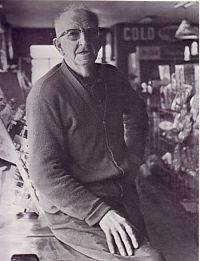
Reginald P. Long, former supervisor of Grand Island and storekeeper, had his own story.
Photo by Nancy Tobin Willig - Click photo for larger view
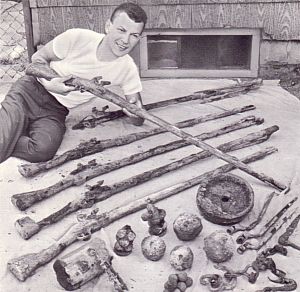
Bud Narachi, with weapons recovered from the Niagara River.
Photo by Buffalo Evening News - Click photo for larger view
Posted at Isledegrande.com July 13, 2006 by Teddy Linenfelser
There's no antibiotic for the treasure fever that lures divers to seek underwater paydays
It was so old a ship - who knows,
who knows?
And yet so beautiful. I watched
in vain
To see the mast burst open with a rose,
and the whole deck put on its
leaves again
--The Old Ship, by James Elroy Flecker
Spanish pieces of eight, those silver-glinting come-ons of treasure seekers throughout this hemisphere, were taken recently from the Niagara River and there is legendary French treasure on Grand Island and its historic Burnt Ship Creek.
"The Great Lakes are loaded with treasure," says Walter Remick, of Great Lakes Research in Cleveland, "and there are payday wrecks available to scuba divers and hard-hat divers - but only the energetic searcher is going to make out."
But before you plan a quick research trip to the library and hurry home to get the boat ready or sharpen the spade, keep two things in mind: "Treasure maps do not actually pinpoint treasure. If the exact site was known it would have been dug up long ago." This is the advice of Robert I. Nesmith of Rye, N. Y., an international authority on pirates, sunken galleons and early Spanish coins.
Another bit of advice winnowed from my own years of treasure hunting from Key West through the Bahamas and into the Great Lakes: You may start out on one search, but invariably you will trip over a half dozen others criss-crossing your main. effort.
Take the Burnt Ship Creek case. For years, you've heard of two ships beneath the waters there, one containing money. You start wading through volumes of local and regional history. One item reads: "Some historians claim that Joncaire, who was in charge of Fort Little Niagara, engaged in building the French bateaux on the island . . When the British took over in 1760, he is said to have burned these boats in the bay at the end of the island and thus it has become known as Burnt Ship Bay."
(Incidentally, although there were many hundreds of bateaux used in local waters, not a single one has been recovered.)
A paragraph in another book reads: "There is tradition that they (the French who escaped from the 1759 battle of La Belle Famille) burned their ships in the Niagara. An indentation in Grand Island still is called Burnt Ship Bay and it is claimed that for many years the charred hulks of one or more vessels could be seen there. But since the French never built on the Niagara after the time of the Griffon, anything larger than bateaux, the legend is deceptive, at least."
This is cold water on your hunt. But read on. Another source talks of a small inlet of deep water "called Burnt Ship Bay in which two sunken hulks of vessels, said, by tradition (and no doubt truly) to be driven in there from Chippewa by the British forces and destroyed by the French Commanders. . . In very low water the timber heads of one of these vessels may be seen a few inches above the surface."
You eat up all available material hereabouts, then spend days off in libraries in neighboring Ontario towns across the swift Niagara. (It was in this river, off Frenchman's Creek that three Buffalo Aqua Club scuba divers - John Kowal, Walter S. Wilczak and Paul A. Cleaver - found the silver pieces of eight in September 1963. They were common among all seamen 150 years ago. The find was made in the ribbed wreckage of an 1812 ship found weeks earlier by Bud Narachi and Donald Rosenthal. They recovered muskets, cannonballs, two small cannon and navigation instruments.)
In the unfamiliar Canadian libraries, your trail freshens when you read that early settlers on Grand Island used to take chain, shot and iron from the sunken hulls of the French ships. "Burnt Ship Bay derives its name from the circumstances here related," you read.
Along the way of treasure seeking, you will stumble on a hard fact: Weeks and weeks of dry, eye-straining research will precede that instant when you strap on a tank of compressed air, adjust your face mask and make the plunge toward that algae-festooned submerged wreck. Or before you turn over one spade of earth.
But take heart. Kip Wagner, who made treasure-diving history by finding the millions amid the sunken 1715 Spanish fleet off Florida, first dived into the Library of Congress before striking it rich beneath the waters off Sebastian Inlet.
After all your reading is done and you have exhausted all available books on the subject, you take another tack. You check with the historians of the locality involved. On Grand Island it is Mrs. Theodore Klingel. She says Reginald P. Long, 77-year-old former Erie County supervisor, knows a lot of Island lore. You stop in at the store he runs on the West River Road. You tell him what you're looking for - some hard information on the sunken wrecks in Burnt Ship Creek. He shakes you up with his own treasure story.
"My grandfather told me about a couple of men who came over here one time from Tonawanda. They gave him $5 for the use of his wagon and also to help them dig. He showed them Burnt Ship Creek. They got out some kind of a map and asked him if that particular tree over there was black walnut. He said it was and they started measuring off distances. My grandfather suggested they measure from a bigger and older black walnut tree. They said he was right and after measuring they began digging. After a while they lifted out an iron-bound sea chest and took it back over the ferry.
"The reason I remember the story is my grandfather used to take me up there and show me the hole left by all the digging."
You listen intently, making mental notes. Then you inquire about those two French ships.
"There was only one," he says with unhesitating sureness. "But it's buried under silt and swamp now. The creek has changed. That old ship was deliberately run aground - on the Island side of the creek, not Buckhorn Island."
You feel somewhat satisfied. The book stuff and this story seem to jibe, roughly. At least one of those elusive ships you've read about is someplace at the bottom of Burnt Ship Creek. You thank Mr. Long and start for the door.
"It wasn't a French ship," he says as an afterthought. "It was from the War of 1812. I'm certain. I had a gun and some shot off it for years, but we had a fire here some years ago and the stuff disappeared."
Treasure hunting frequently pans out like this.
But you yarn about the episode in a letter to a fellow treasure buff who lives near Cape Hatteras. Back comes his note: "Don't give up on Grand Island. Did you ever hear of the gold and silver coins found there in 1888? One was dated 1537 and coins of later dates were found nearby and two French frigates were alleged to have been scuttled nearby, one with a pay chest on it. The coins were found in a circular stone foundation at the water's edge. This stone base was exposed by a storm which had lowered the water."
There it is again, with nagging insistence. Two French ships. And money. The date on the coins - some not too far from the 1759 date of the French-English collision at LaBelle Famille.
You get off a half dozen letters (Treasure hunters keep a fleet of letters sailing back and forth.) From Arlington, Va., comes: "The house is not far from the water, as ships used to unload cargo there and it is believed a number of chests are buried nearby . . ."
On with the bifocals and you hit the libraries again, looking for more obscure sources and references.
J. B. Lippincott Co. in 1896 published the very material you want. It's Charles M. Skinner's Myths & Legends of Our Own Land. You find what you want on page 286, Vol. II. There it is, the pristine story of a Frenchman, Clairieux, money chests, buried French ships and coins exposed by a gale.
You're off and running again - toward more research. The fact that the gale occurred in 1888 sounds like a good place to start testing the tale. You plow through weather history and records. Wow! It's enough to trigger hypertension: That was the year of the fabulous Blizzard of '88. Locally, there was no snow but there was sustained high wind which exposed area beaches. . .
Any map of a locality where treasure is supposed to be buried is a treasure map. There are authentic ones, of course. But most of those printed are published as wall decorations. Sometimes they are of some historical value, and they are exciting to the eye.
A real treasure map usually is a navigation chart, with X marking the spot - if you're lucky. The best treasure maps are those precise and technically excellent charts issued by the U. S. Army Corps of Engineers. Companion pieces are the geological quadrant maps issued by the U. S. Dept. of the Interior.
These are the aids you want when you decide to go after the La Jean Florin and its reputed $500,000 cargo of gold and silver. She went down July 2, 1721, off Barcelona, N. Y. Or the Anthony Wayne, a steamer lost off Windmill Pt. with whiskey and $100,000 in gold aboard.
There is no antibiotic available for treasure fever -whether it's submarine wreckage or land-bound booty. The best medicine is to get from the Library of Congress its new 29-page booklet, A Descriptive List of Treasure Maps and Charts. Take as frequently as required.
Editor's Note: Send your opinions on this article and your treasure stories regarding the Grand Island area to "teddy@giecom.net".
Dairying On Grand Island, N.Y. - 1933
30 League Members Have Empire of Their Own in the Middle of the Niagara River Near Buffalo
By Ted H. Townsend
Published in The Dairymen's League News, 1933
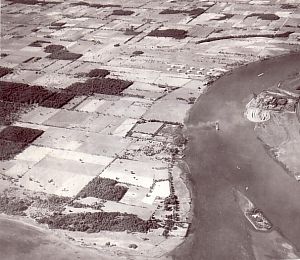
An airplane view of Grand Island showing some of the League farms in the foreground.
Click photo for larger view
Posted at Isledegrande.com June 22, 2006 by Teddy Linenfelser
"Thirty dairy farmers on an Island. Milk brought to market on a ferry. It sounded fantastic when John H. Drought, Division Representative at Buffalo, said there were 30 dairy farms on Grand Island in the Niagara River. It was worth investigation."
For this complete story published in 1933, click "Dairying On Grand Island."
100+ Years Of Boat Racing On the Niagara
"Thunder On The Niagara" - June 3-4, 2006
Posted June 1, 2006
By Teddy Linenfelser
Click photos for larger view
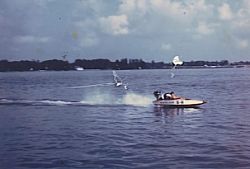
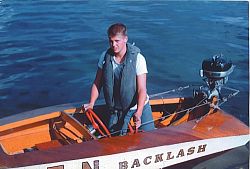
Mike Sceusa and his boat Backlash in 1961. Click for "Mike's Story"
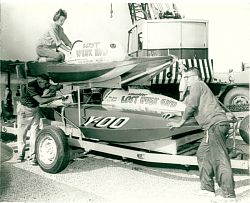
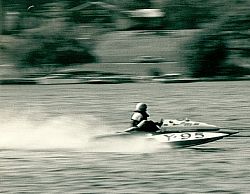
(left) Gene Roesch, with daughter Lynor Roesch Turner and son, Gary working on the "Lost Week End" in July 1962. (right) Gary is driving Frank Reichlin's "Miss Peggy" in the 1970s. Click for "Gary's Story"
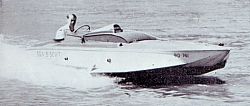
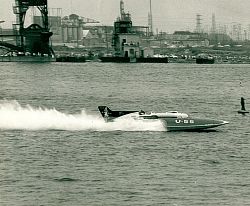
(left) Al Brinkman in "Sea Biscuit," 1942 - (right) 1960 photo of "The Gale" owned by Lee Schoeneth and driven by "Wild Bill" Cantrell, both of Detroit
Be sure to click photos for larger view.


John Krebs will be driving a new boat for Lauren Malkiewicz in 2006. John has taken 5th in National Modified National Points, 2005 "Skeeter Johnson Memorial National Modified Champion," 2nd in National Modified "Power in the Park" Portsmouth, VA, and 4th in the 2006 National Modified Eastern Divisionals.
Be sure to click photos for larger view.
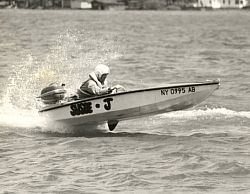
Rollie Radder driving his Susie-J on August 28, 1961. Click for "Rollie's Story"
Be sure to click photo for larger view.
The thrill, the noise, the power, the excitement and the carnival atmosphere of yesterday are all part of what "Thunder On The Niagara" is all about and what brings thousands to the Niagara River shores to witness the extremely high-speed hydroplanes on the rough course of the narrow and swift Niagara.
Boat races have been planned and cancelled in recent years with the last races taking place in July 2001 at North Tonawanda's Gratwick Park. However, "Thunder On The Niagara" Hydroplane Races are definitely set to take place this weekend - from 10:30 a.m. to 6 p.m. Saturday and Sunday, June 3-4 at Gratwick Park. General chairman is John Krebs, Commodore of the Niagara Frontier Boat Racing Association.
Cost to get into the park for what should be the best view is a $2 donation to benefit Carly's Club. According to Krebs, racers will include Island residents Greg Barker (Owner - Honey Bun - S-9), Don Less ( Owner - CentsLess 12 - E-600 & CentsLess 14 - E-500), Joe Less (Driver - CentsLess 12 - E-600), Ken Brodie II (Driver - CentLess 14 - E-500), Alan Bush (Owner/Driver Brand New Boat), Lauren Malkiewicz (Owner - Just Crazy E/NM-233), and John Krebs (Driver - Just Crazy E/NM-233). Former Islander, and three-time national champion, Dan Kanfoush, now a resident of Niagara Falls, will also be racing.
A History of Boat Racing on Grand Island, N. Y.
The 100+ years of boat racing on Grand Island has yielded many winners and world champions.
Boat racing off Grand Island, N.Y. goes back to 1905 as the Buffalo Launch Club's fame as a power boat racing club began when the team of George and Harry Elliott won the club's first regatta cup with a spectacular record speed of 18 mph. Races were held over the course of the Buffalo Launch Club on September 8, 1906 and included the combined fleets of the Launch Club and the Motor Boat Club of Buffalo. Click for BLC 1906 Race Story.
Over the next 10 years the Launch Club regattas were an annual Niagara River sporting event, drawing a list of nationally known sportsmen including Edsel Ford, Gar Wood, Dick Locke, Horace Dodge, William J. Connors, Robert Ringling and Harry Greening.
The BLC received a sum of $5000 from the City of Buffalo as an inducement to run the race course past Riverside Park to benefit the general public. There are conflicting reports of what caused the canceling of the city's "grant." One is of a boat careening into the Park shoreline, injuring several people, the withdrawal of the funds and the end of the International Regattas in the mid 1920s. Another report was that the races ended due to the fact that "pleasure cruisers" became the popular boat of choice for many BLC members in the 1920s and were dominating the Club's boating activities.
During the Regatta at the Launch Club in 1922 Horace Dodge with his Baby Holo won the international trophy event with a speed of 64.06 miles per hour.
New in 1927 were the outboard speedsters and Francis Brobeil, driving his K-D-Did won the race at the Buffalo Launch Club regatta. Miss Buffalo lost to the Miss California driven by Dick Lyones of Los Angeles in the 151 division in a field of 10 boats that weekend. And in the BLC regatta of 1929 Brobeil was the winner in Class B and C outboards. The Buffalo International Aquagatta program dated June 1942 referred to the 1930 BLC Regatta as a "one-man show, presented by Fran Brobeil who won all but one heat of outboard hydroplanes and piloted Bob Huntley's Miss Buffalo to a 3-heat win in the 15` Division. Drivers in a regatta at the Sandy Beach Yacht Club in 1941 included famed band leader of the Royal Canadians, Guy Lombardo, driving his Tempo II, and Al Brinkman of Buffalo, N.Y., Canadian National 225 Champion at the time who had not yet moved to Grand Island.
Launch Club Commodore C. Roy Keys put his new hydro-drome through the test in 1928. According to a newspaper report, "the hydro-drome, like an unleashed greyhound, roared into the water, rose majestically on its stilts until the whole bottom of the boat was visible."
A pleasure ban including the operation of power boats took place during the World War II. The exception to this ban was speed boat contests. The Mercury Power Boat Club sponsored a speed boat regatta at the Bedell House on Sunday, June 4, 1944 when racers included Islanders Paddy Fix, Dick Voight and Ollie Howard. The boat races continued every other Sunday off the Bedell House.
The Buffalo Launch Club purchased another 165 feet of riverfront in 1946 and enlarged the basin and dock facilities. Speedboat racing, "sparked by George J. Trimper, former boat racer and world record holder," was revived at the Club in 1947 and drew 25,000 spectators to the Island. These annual international regattas over the Niagara River course put the BLC back in the forefront of major boat racing across the nation. In 1950 and again in 1952, the Buffalo Launch Club became the recipient of the most coveted award, "Outstanding Drivers' Regatta in the World." It was George Trimper and his committee who conducted the regattas for 14 years, drawing the most competitive of the limited and unlimited racing teams. Not once, but two years in a row, the American Power Boat Association pronounced the BLC's international regatta as the best regatta staged on the continent.
The 48-cubic-inch runabouts were the newest class of racing when the BLC's International Regatta was held in August 1950. Joseph Van Blerck Jr. in his reliable "Aljo" won the national championship in the seven liter class when a reported 50,000 people witnessed the Sunday races. Grand Island's Al Endres, driving his "Sour Puss," took a fifth place but it was Guy Lombardo's "Tempo VI" that won the feature event for unlimiteds by nearly a mile. A late afternoon feature was a race for old-timers' speed boats.
The annual two-day regatta off the Buffalo Launch Club in August 1953 was held on the "extended" 2 1/2 mile Niagara River course. The event attracted over 150 entrants, including many national and world champions in competitions for runabouts, hydroplanes and seven-liter boats. Among them were Sherm Crechfield, national champion in the Class E; and former world record holder, Dick Rankin of Pontiac, Michigan in "Hi Ball"; Art Hatch, an outstanding Canadian driver in "Costa Lotta" and "Lotsa Costa"; orchestra leader Guy Lombardo in his Tempo VI; and of course Grand Island, N.Y. champion in his own right, Al Endres who won the National E crown, regaining the title he won at the BLC in 1951.
The boating world was deeply saddened when 29-year-old Al Endres, who won one of several International Regattas off the Buffalo Launch Club in 1953 and then nine days later, after winning again in Maryland, collapsed and died. Click for "Al Endres Feature Story" that includes mentions of his father, Ed Endres, his son Mike Endres, Al's granddaughter, Anne Barker, and her grandfather and father, Ralph Barker and Greg Barker, all involved in boat racing.
Boat racing on the Niagara River continues to be just as popular in recent years as it was in its past. Most recent grand champion boat racers include Bob Catipovic, Greg Barker, Don Less, and former Island resident Ken Brodie II.
Click for "Excerpts In Island Boat Racing History". This page includes participants of all levels of racing including some of the winners and champions who put Grand Island's boat racing on the map.
See also "Phil Killian Remembers Boat Racing In The 1940s, 50s"
Many names are missing and you are invited to submit for consideration your name, boat name, years and successes to "teddy@giecom.net"
The Town Commons - First Town Hall Built In 1875
Posted April 27, 2006
By Teddy Linenfelser
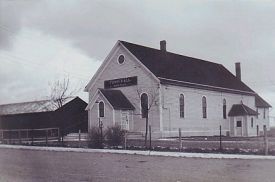
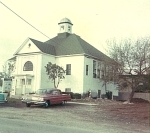
First Town Hall built in 1875, later became the Fire Hall School #9 became the town hall in 1938.
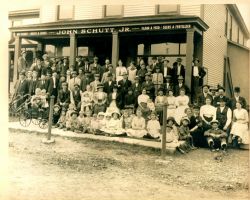
Schutt's Store, built around 1907, stood around the corner from the town hall. John Schutt served as town clerk when the photo was taken and his office sign on the left is barely visible. The store was bought out by Ernie and Edith Godfrey in 1945. It had a ‘buggy room’ on the second floor with a big elevator and hoist to carry the carriages to the display room. At that time (1945) it still had quite an inventory of farm stock which the Schutts carried, such as big brass rings for bulls’ noses and a variety of oil lamp chimneys. Godfrey’s Grand Island Market was strictly groceries until about 1950 when they turned the 2nd floor into a 5 & 10 cent store.
Click photos for larger view.
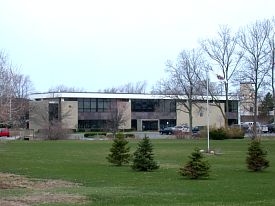
Today's Grand Island Town Hall - Jodi Robinson Photo - Click for larger view.
Land in the center of the Island, now known as the Town Commons, where the Grand Island Town Hall and Fire Company headquarters are now located, was at one time owned by Adam Kaiser and
John Schutt who built his store on the Whitehaven Road side of the property. It was on this same property that the Island's first town hall was built in 1875 when Conrad Spohr was serving as town supervisor and the Island's population was 1072 people. Before that time, town business was conducted in the homes of town officials.
When the first central school building, Charlotte Sidway, was opened in February 1937, the school houses became vacant. School #9, built in 1918 and located to the right of the original town hall, was a much newer building than the 1875 hall, and became the town's headquarters in 1938. At the same time the new Grand Island Volunteer Fire Company was formed and the older building was turned over to the firefighters' organization. A small addition was built on the right side by the men to house the Company's truck and equipment.
The horse sheds on the left of the old town hall were built in 1903 by Leonard Geschwender at a cost of $500. Originally on the south side of the Hall to shelter horses while residents attended meetings and events, the sheds were moved in 1918 when School #9 was built. An east side addition to that first town hall, constructed in 1924, was used for town board meetings and town business.
Voters on Election Day, November 8, 1938, passed the proposition to take over School #9 for town offices and in December of that year, the offices of supervisor and town clerk were moved from the homes of those in office into the new Town Hall, remodeled for that purpose.
That first town hall, circa 1875, was a popular place for dances, card parties, church and community meetings, rehearsals, and dinners. In Miss Martha Kaiser's "Daily Journal" in October 1905, she wrote: "Went to the Harvest Home at the Town Hall and had a good supper." And in November 1905 her entry was: "I attended both services today and played the organ. Anna and Lydia were at the Town Hall (service) this morning." Other entries regarding that first town hall follow:
• Oct. 22 - "I went from there to the church business meeting at the Town Hall. Pa is president of the Church Building Committee."
• Fri., Nov. 30 – "Walked to the Town Hall this evening to attend the Literary Society meeting."
• Fri., Dec. 7 – "I attended a business meeting at the Town Hall."
• Sun., Dec. 9 – "I attended services this morning at the Town Hall and this evening at the Congregational Church."
• Sat., Dec. 15 - "Charles Long and Charles Kaegebein got piano for the Town Hall. It belongs to the church."
• Fri., Dec. 21 - "Had supper with Mrs. Scheib before going to rehearsal at Town Hall."
The basement of #9 School, the town hall at the time, was converted into the town's first library in 1946 and remained there until the present town hall was opened in 1968 with a second floor library facility.
In 1966, when plans for a new town hall were in the works, a Grand Island Historical Society representative attended a town board meeting and asked that the former school house be preserved for its historical value and to permit its use as a meeting place for Island organizations.
The original town hall, circa 1875, was in use for approximately 78 years, and was torn down in 1953 at the time the new firehall was nearing completion.
Congressional Medal of Honor
Awarded Posthumously To Charlie DeGlopper 70 Years Ago
Posted March 9, 2006
By Teddy Linenfelser
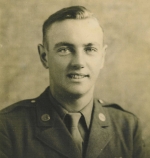
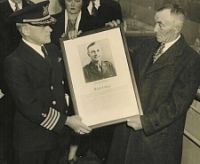
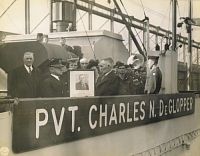
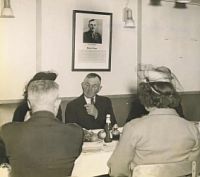
Charles N. DeGlopper - Pvt. DeGlopper's father, Charles L., receiving Congressional Medal of Honor plaque - Pvt. DeGlopper's father at the renaming of a ship in honor of his son - dinner in Trinity EUB Church
Click photos for larger view.
Charles L. DeGlopper, a Fix Road, Grand Island farmer, received the Congressional Medal of Honor awarded to his son, Pfc. Charles N. DeGlopper, who was killed in France on June 9, 1944. The event took place 70 years ago, on Sunday, March 10, 1946 before 350 friends and neighbors in Trinity EUB Church. Presenting the medal was Maj. Gen. Leland S. Hobbs. Private First Class DeGlopper was a member of the U.S. Army, Co. C, 325th Glider Infantry, 82d Airborne Division. He was born on Grand Island, N.Y. and died at Merderet River at la Fiere, France, June 9, 1944.
The following citation was read in Trinity Evangelical Church, Grand Island, N.Y. on March 10, 1946:
He was a member of Company C, 325th Glider Infantry, on 9 June 1944 advancing with the forward platoon to secure a bridgehead across the Merderet River at La Fiere, France. At Dawn the platoon had penetrated an outer line of machineguns and riflemen, but in so doing had become cut off from the rest of the company. Vastly superior forces began a decimation of the stricken unit and put in motion a flanking maneuver which would have completely exposed the American platoon in a shallow roadside ditch where it had taken cover. Detecting this danger, Pfc. DeGlopper volunteered to support his comrades by fire from his automatic rifle while they attempted a withdrawal through a break in a hedgerow 40 yards to the rear. Scorning a concentration of enemy automatic weapons and rifle fire, he walked from the ditch onto the road in full view of the Germans, and sprayed the hostile positions with assault fire. He was wounded, but he continued firing. Struck again, he started to fall; and yet his grim determination and valiant fighting spirit could not be broken. Kneeling in the roadway, weakened by his grievous wounds, he leveled his heavy weapon against the enemy and fired burst after burst until killed outright. He was successful in drawing the enemy action away from his fellow soldiers, who continued the fight from a more advantageous position and established the first bridgehead over the Merderet. In the area where he made his intrepid stand his comrades later found the ground strewn with dead Germans and many machineguns and automatic weapons which he had knocked out of action. Pfc. DeGlopper's gallant sacrifice and unflinching heroism while facing insurmountable odds were in great measure responsible for a highly important tactical victory in the Normandy Campaign.
The following was written and read by Lt. Col. Heber Ashley:
Charles N. DeGlopper
As I Knew Him
Twenty-five years ago, on the 30th of November, the stork dropped a pink and white bundle of humanity into the waiting arms of his proud parents, Mr. and Mrs. Charles Leonard DeGlopper, at their home on Fix Road, Grand Island, New York.
The happy mother said, "He will be President of the United States," the father said, "He will be a great man, and a good man of whom we will all be proud."
They were prophetic, because Charles N. DeGlopper became one of the nation's heroes.
In his childhood days Grand Island had no electric lights, no bridges, no bus lines and few good roads. There were 11 small one-room schools scattered over the Island. Charles went to one of these schools, #5, about a mile from his home. He acted as janitor for several years and having a natural genius for mechanical things, he kept the furnace in good working condition and made small repairs where needed. The money he received for this work was still in the bank when he entered the Army. He had planned to use it for a college education.
In common with most heroes, he led a natural, happy life and enjoyed the things that most boys enjoy. He loved to go out in the early morning to hunt, and always had his 22 rifle at hand, looking for game, and thus became an excellent shot. He loved to fish and was often the first to bring in a good catch of fish in the Spring, after the ice went out of the Niagara River.
He was fond of athletics and sports of all kinds, and I have often watched him play baseball and touch football with the other boys in our yard, for hours at a time. He seemed tireless, and was always considerate of the younger boys in the group. Swimming was a regular hobby of his, indulged in frequently every summer.
Charles completed his education in the grammar school and went on to Tonawanda High School, graduating in June 1941. He was well liked by his classmates who referred to him as "Chuck" and his chief characteristic in his yearbook was considered "amiability." He was always cooperative and willing to go along with any project, and showed great loyalty to his friends.
On Sunday morning Charles was always to be found in Emmanuel Chapel Sunday School. It was my great pleasure to present him with a Bible, with his name inscribed in gold letters, for perfect attendance for the year 1933. He was always dependable and enjoyed taking part in the socials, picnics and programs of the Church.
One of his chief delights was to take his father's team and sleigh or hay rack, loaded with straw and gather up the young folks for a ride around the Island, stopping at the home of one of his friends for coffee and sandwiches, games or dancing.
One of his hobbies was woodworking and he made several fine pieces of furniture for the home. He liked music, too. He could turn his hand to cooking and his favorite recipe was banana cake with whipped cream.
When he entered the Army in 1942 he was 6 feet, 7 inches tall and weighed 240 pounds. On this account it took five weeks to outfit him at Fort Niagara, and he had great difficulty to secure shoes of the proper size while overseas.
Sorrow also entered his life. His brother, Robert, died when he was 11 years old and he suffered an even greater loss when his mother was taken from him at the age of 16. He was the youngest of fur and a great favorite with the whole family. In spite of these tragedies he carried on, and did more than his share of the home and farm work, while keeping up his school work, and outwardly, was his usually cheerful self.
He was very fond of children and loved to take care of his nephews. This had an influence on his conduct in the Army and was in some measure responsible for his heroic conduct. He was determined that his buddies would get back to their families. He had full realization of what it meant to them.
While in England he kept up his Church contacts and the Church in Leicester, Leicestershire placed his name on their honor roll and his name was read at their Memorial Services.
He became acquainted with an English family in Leicester and they remained fast friends. When tragedy befell him some of his wounded buddies who were hospitalized in England looked up this family and gave them the sad news. They then began a correspondence with Charles' family which has been continued.
While in England he realized one of his boyhood ambitions which was to visit Scotland, the ancestral home of his grandparents. He was given a ten-day furlough. Among the places visited was Glasgow and Edinborough and he had the privilege of ice skating on Lock Lomand, immortalized by Robert Burns.
He had the happy fortune of meeting one of his high school chums, Sgt. Robert Niland, in England and they had many good times together. Sgt. Niland himself was also missing in action shortly after D Day.
During the war he was separated from one of his life-long pals, Lester Yensan. They never met again. Lester before returning home visited his chum's grave in the Military Cemetery at Bloisville, France.
His last letter to his family was written on D Day, in this he told his father about his buddies and declared that it would not be any fault of his if they did not get safely back. And we all know now how he kept that promise.
To the end he was courageous, slow to anger, thoughtful of others, kind, understanding, religious, steadfast, loyal to friend and country, and when the supreme test came he met it with unflinching fortitude and valor.
His life is a shining and outstanding example for the guidance of the youth of our Nation.
The lesson which his life has taught us is fearfully and wonderfully portrayed in the words of John McCrae in his deathless poem, "In Flanders Fields."
In Flanders Fields
In Flanders fields the poppies blow
Between the crosses, row on row,
That mark our place; and in the sky
The larks, still bravely singing, fly
Scarce heard amid the guns below.
We are the Dead. Short days ago
We lived, felt dawn, saw sunset glow,
Loved and were loved, and now we lie
in Flanders field
Take up our quarrel with the foe:
To you from failing hands we throw
The torch; be yours to hold it high.
If ye break faith with us who die
We shall not sleep, though poppies grow
In Flanders fields.
Click "DeGlopper Legacy"
For Ruth Stahl's "Treasures" column on Charlie DeGlopper, click "Charlie"
Eugene M. Dyczkowski's Andrew Shaffer Painting Lost - 2006
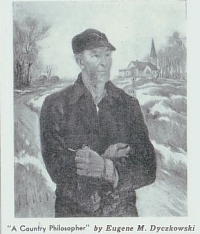
"A Country Philosopher" by Eugene M. Dyczkowski
By Teddy Linenfelser
Posted March 2, 2006 - Click photo for interesting detail
A lost family heirloom, with ties to Grand Island, New York, is the object of a search in hopes of resurrecting the painting, "A Country Philosopher," by local artist, Eugene M. Dyczkowski, now deceased. Born in Philadelphia, Pennsylvania in 1899, the well known artist's shows included the 1929 World’s Fair in Posen, Poland.
According to Patricia A. Adams, a family member leading the search, "In the late 1930s, Dyczkowski created an oil painting using the subject known as "Uncle Doc." Uncle Doc was a clairvoyant, or more appropriately in that era, "A Country Philosopher," as coined by the artist who painted his portrait. During that time, The Buffalo News featured an article on Uncle Doc and his life on Grand Island.
"The painting was also on exhibit at the Hotel Statler by the Buffalo Society of Artists, of which Mr. Dyczkowski was president. After that time, the painting hung in Uncle Doc's home until his death (approximately 1949). Uncle Doc's favorite niece, Allene Campbell (of Tonawanda) is unsure what happened to the painting at that time...The family consulted a psychic who claimed that the painting had not been destroyed and was still in the Buffalo area."
Any information on this painting would be most appreciated and may be mailed to Patricia A. Adams,
160 Quail Hollow Lane,
East Amherst, NY 14051 (716-639-3721 Home - 716-479-0302 Cell - email padams@OCDUS.jnj.com).
For the article, Philosopher Thankful for Nature - Grand Island Peaceful Amid Strife, click Buffalo News Article - 1930s.
Dairying On Grand Island, N.Y. - 1933
100+ Years Of Boat Racing On the Niagara
The Town Commons - First Town Hall Built In 1875
Congressional Medal of Honor
Awarded Posthumously To Charlie DeGlopper
Eugene M. Dyczkowski's Andrew Shaffer Painting Lost
Army’s Nike Guided Missile Antiaircraft Battery Near Completion - Grand Island, NY
Published in the Island Dispatch - September 26, 1956 - No Author
Posted By Teddy Linenfelser on November 16, 2006
The Army’s Nike guided missile program in this area is beginning to take shape after more than two years of intensive construction and planning.
At one time, curious residents were asking antiaircraft officers, “What happens to the man riding in the missile?” Since that time, however, the lid of secrecy on the supersonic weapon has been largely removed. Western New Yorkers have grown to accept Nike as a vita component of the area air defense setup.
Guided missile sites at Model City and Cambria Center in Niagara County and on Grand Island in Erie County already are “operational.” Sites near Millersport, East Aurora and Hamburg are expected to be finished by the end of the year. A seventh site in the Town of Lancaster is scheduled for completion during 1957.
“Beautification” programs now are under way at the Model City, Cambria and Grand Island sites. This includes landscaping and the planting of trees and shrubs.
According to recently released Department of Defense reports, the Nike missile has a “slant range” of 25 miles. Target-tracking radar computes the path of oncoming enemy aircraft. When the missile is launched, both target and missile tracking radars work in unison, one locked on the target, the other on the missile. On the basis of data from these radars, guidance is provided the missile to intercept and destroy the target.
A series of electronic impulses from ground to air prevents the missile from hitting friendly interceptor planes. Each friendly aircraft has an electronic means of identifying itself. The principle works somewhat like the identification of different radio frequencies.
A Nike installation, the Army insists constitutes no danger to the area nor to the personnel of the unit itself. A warhead on the missile is constructed to explode only in flight. It has a self-destructive feature so that it will not crash and explode. In case the missile misses its target, battery technicians can also burst it from the ground by electronic impulses.
At the various sites, safety precautions are taken for storage of explosives and volatile fuels. Assembled missiles are stored underground. Fueling areas are surrounded by high earthen revetments.
The missile itself, named after the Greek goddess of Victory, is liquid fueled and measures bout 20 feet in length and one foot in diameter. It has two sets of fins for guidance and steering. The missile together with an 11-foot booster, weighs slightly more than a ton.
When launched from an elevated rack the missile is attached to the booster. This booster gives it the initial thrust, launches it, and gets it up to flashing speeds before it is jettisoned a few seconds later when the Nike takes over and streaks on under its own power. Nike is normally fired from an almost vertical position.
The Nike project was initiated by the Army in 1945. The first Nike battery to become operational was installed at Ft. Meade, Md., in December 1953.
The Department of defense, however, noting that the Niagara Frontier was the tenth largest industrial area in the country, started laying plans for antiaircraft defense here as early as 1950.
Several million dollars was subsequently appropriated and 1,000 men from Ft. Devens, Mass., were sent here in October 1952. the first Nike site at Model City was started August 4, 1954.
The 2nd AAA Group at Ft. Niagara is the antiaircraft defense headquarters for Western New York. In case of an enemy air attack, the headquarters would coordinate their activities with the Air Force’s 15th Fighter Group at the Niagara Falls Municipal Airport.
Each of the group’s three operational Nike sites are self sustaining. About 200 men at each station eat, sleep and work within the site.
The personnel responsible for getting the missile into the air are highly trained technicians. Electronics maintenance men, for instance, have all completed a 32-week course at the Army’s guided missile school at Ft. Bliss, Texas.
All personnel associated with the actual firing of the missile go to the Army’s firing ranges in New Mexico each year for target practice. Excepting for an actual enemy attack, no missile ever will be fired here.
Although no missiles are actually launched in this area, the efficiency of each Nike battery can be accurately tabulated.
Each site covers approximately 40 acres. Six to eight acres are set aside for a control area and the remainder for the launching area. There must be an unobstructed line of sight between both areas.
Various types of computers, radars and associated control equipment are located in the control area. In the launching areas, there are from three to six missile launchers. The areas are manned 24 hours a day.
Area antiaircraft officers are looking forward to the appearance of the Nike “B,” the Army’s latest guided missile. It has greater range and striking force than the present Nike. At least one launcher at each of the area sits is equipped to handle the new weapon. Presumably, all launchers eventually will have to be converted to accommodate the new missile.
A Country Teacher’s Diary - 1905
Posted at Isledegrande.com October 27, 2005 - - Scroll down for December 1905 entries
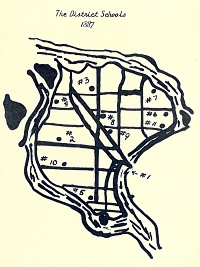
Artwork by Joanne Senn. Be sure to click school map (1887) for a larger view.
This Grand Island map shows the location of one- and two-room school sites that were in existence in 1887. Some were moved, some burned or were torn down. Miss Kaiser, who wrote the diary, was teaching at School No. 9 on Baseline Road, south of Whitehaven Road at the time. That building burned to the ground in 1917 and was replaced with a school house, north of Whitehaven the following year.
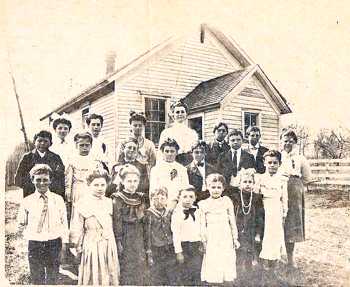
Martha Kaiser Schutt is shown with her class in front of No. 3 School, located between Long and Huth Roads on Baseline Road. Shown front left are Theodore N. Van Son, Fanny Trautman, Esther Ziehm, Myron Ziehm, Charles Roe, Emily Aderman and Rosetta Frentz; (2nd row) Clarence Ziehm, Mary Frentz, Nelson ?, Clara Trautman, Ernest Aderman, John Roe, and Lovina Aderman; (3rd Row) Bertha Roe (Bucher), Minnie Aderman, Hanna Frentz, Martha Kaiser Schutt, Elmer Ziehm and Della Long.
October 1905
Oct. 1 – Uncle George helped Pa load hay. Took it to Buffalo. Got $31. Ma took Schloerbs to ferry. Schiebs bought horse from George Dinsmore today. It is a cool day. I rode home from school with Ma.
Oct. 2 – It is a beautiful day. I rode to school with Pa. Sent and received letters and postals. Prayer meeting was at our house this evening.
Oct. 3 – Fourteen pupils were in school today. Ma and Pa went to Buffalo and the girls took advantage of the beautiful day to wash. Grandma fell and hurt herself. Ma bought a new hat in the city. It cost her $2.50. Also, bought two baskets of peaches at 65 cents. The girls have gone off to a husking bee at Charles Kaegebein’s this evening.
Oct. 4 – It rained very hard today. Pa came to school for us this evening
Oct. 5 – It was a nice day. Went to the Harvest Home at the Town Hall and had a good supper. We met Mrs. Bert Morgan. It rained on our way home so we took refuge in the church shed until it let up.
Oct. 6 – It rained all day today. We made tomato preserves and pieced a quilt. Pa went to the ferry to meet Frank. He did not come.
Oct. 7 – Did not go to church today as it is still raining and has turned quite cold. Hear there were 17 persons present at the evening service. We covered flowers as it froze quite hard about 12 o’clock.
Oct. 8 – Got along nicely at school today. Grandma is not sitting up at all. Folks dug about 40 bags of potatoes. Mrs. Alvin Buesch died suddenly this afternoon. It is very windy tonight.
Oct. 9 – It rained all forenoon. There were only 11 pupils in school today. The Erie County Sunday School Convention was held in Tonawanda. It has cleared this evening.
Oct. 10 – Ma, Pa, and Lydia went in to Buffalo today. Lydia got a new coat for $7 and a hat for $1.98. New rubbers cost 65 cents. It became quite cold and rained this afternoon. Toward evening it turned to snow and a big storm has begun. The snowflakes are large. Kenocke’s moved into Buffalo today.
Oct. 11 – It is snowing still! Big John was here early and I rode to school with him. Pa brought the girls. There were only 7 pupils in school. I seem to have gotten a bad cold. Mrs. Buesch was buried this afternoon. Pa came for us after school. I covered flowers when I got home.
Oct. 12 – It has developed into a hard freeze. Looks like genuine winter! Ma and Pa went to the doctor’s in Tonawanda. Dark clouds are in the sky. I walked to school. Stopped on my way home to visit with Mrs. Rothen and Mrs. Schieb. Wrote letters this evening.
Oct. 13 – Ma and I took up plants from the flower beds and I raked the yard. Received word from Nell Porter in West Virginia. Except for meals and reading postals, spent the day out-of-doors. The weather is quite lovely. Pa was at Persons today. Frank came home this evening.
Oct. 14 – Grand Day! Attended both church services. Went to Esther’s from church and went with her to Sunday School in the P.M. We walked with the Henry Schutts, Irene Williams, etc. Had a nice visit with Mrs. Fenner. Ma and Pa took Frank to the ferry.
Oct. 15 – Lovely, mild weather. Enjoyed school today. Ruth, Cleo and I went to Long’s Dry House. We rode down with Fred Ehlers. Mr. Claus took us through. Miss Swale also there. Walked home where a letter was waiting from Mary Schafer. She tells me she is to be married on Oct. 27. Uncle Adam and Allen were here this evening.
Oct. 16 – Lovely day. Ten pupils were in school. Many are helping with the Fall work which accounts for much of the absenteeism. John Schutt passed the school with his silo machinery. I took the children to the woods at noon together colored leaves. The roads are getting better. Was invited to Schiebs’ for supper. Mrs. William Buesch and her son, Charles, were also there. They came this afternoon to dig their potatoes. Our folks finished digging today. Prayer meeting was held at the Rothens tonight.
Oct. 17 – Pleasant day. The Rev. Luxford called at the school. Folks are getting apples from the orchard on Baseline. The girls went to a husking bee at Mrs. Joe Long’s this evening. Rothen helped Uncle Adam with his potatoes. Our folks are at the apples. Mr. Schutt got 60 cents a bushel for apples at market.
Oct. 18 – Pa went into the city with apples and got 65 cents and 75 cents a bushel for them. Ma and the girls picked apples today and Uncle Adam finished digging his potatoes. It was cloudy this morning but cleared up through the day.
Oct. 19 – Sometime between 1 and 2 a.m. our church burned. The cause of the fire is unknown. Rothen came up and called for Pa. It rained hard throughout the night and all day today. Pa took us to school. Laura Stamler came right over to talk “fire.” There were just 6 pupils at school. Pa took us to and from the church.
Oct. 20 – I helped with the work all day. Ma went over to the Hulings and Pa was at Spohr’s on church matters. Charles Long and John Schutt came here for supper. Pa went down to the ferry for Frank and Mr. Walsh. The roads are quite muddy.
Oct. 21 – I did not attend church all day. Helped Ma get dinner. It began to rain as the girls were getting ready for church so no one went. It continued to rain all day. Went to William Dinsmore’s on business.
Oct. 22 – Erdman and Heiman’s first day of school. It was a very trying day and I kept two boys until almost five o’clock! Had supper at Aunt Mary’s I went from there to the church business meeting at the Town Hall. Pa is president of the Church Building Committee. Also serving are H. W. Long, John Schutt, Henry Ehde, Adam Kaiser, the Rev. Rothen and William Rhode.
Oct. 23 – Weather cleared up. Had a more pleasant day today. Eighteen pupils were present. This morning it rained so hard as I was walking to school that I got wet though to the skin. Ruth and I had a duck supper tonight at Schiebs. Pa was attending a building committee meeting at H. W. Long’s.
Oct. 24 – Pa went into the city with hay today. There was a husking bee at Henry Ehde’s tonight. The Hulings came to go over with us. A severe rain storm began so none of us went. George Alt had stopped by here, too. We spelled, sang, etc., and everyone left around 11 p.m.
Oct. 25 – Anna took us to school as it is still raining very hard. The building committee is in Tonawanda making arrangements for a new church building.
Oct. 26 – I walked to and from school. It is a pleasanter day than usual. Mrs. Schieb, Mrs. Buesch, and Leonard Geschwender came to school at noon today. Went to the spelling bee at the school this evening with John. I was next to the last to go down on our side. Marie Stoll stood up the longest. There was a good crowd and 10 cents was charged. They served cake and coffee. Henry Hardy and John were the only boys on our side of 16. I got a box of candy this evening.
Oct. 27 – Helped with the Saturday work and made dressing saques. Pa went to Buffalo with potatoes which he sold at $1 a bag.
Oct. 28 – Did not attend church all day. It was rainy and cool.
Oct. 29 – Cool. Got along nicely at school. Margaret was over this evening.
Oct. 30 – Pa went to the city with butter and eggs. Some of the eggs sold for 38 cents a dozen. The butter went for 32 cents a pound. It has been very rainy and disagreeable all day. It began snowing quite hard during the late afternoon. After school we took the geraniums into the cellar and plants into the house.
Oct. 31 – Pa went to the city with 25 bags of potatoes at a $1 a bag. I finished two percale aprons this evening. We put the clothes to soak. George Alt came by this evening to get our wagon. Received a letter from Mary Schafer who was married last Saturday and is now living in St. Louis. She also sent a piece of the wedding cake!
November 1905
Thurs., Nov. 1 – We were able to wash on this “All Saints Day.” Pa acted as clerk for Mrs. May’s auction. He received a $3 fee. The roads were very muddy.
Fri., Nov. 2 – The day has been quite clear and pleasant even though the roads are still in their muddy condition. Got along nicely at school.
Sat. Nov. 3 – Worked out of doors most of the day. I dug up dahlias. Ma, Pa, and the girls got apples from below. This afternoon Pa went to the ferry to meet Frank but he did not come.
Sun., Nov. 4 – Attended services at Long’s church and taught both Rothen’s and my class. Rothen preached in the morning. Luxford had the evening service and preached on “Dancing.” Henry Williams, John Young and his wife were here in the afternoon. I visited the Trautmans this evening for a few minutes. The day has been cool and windy.
Mon., Nov. 5 – Another pleasant day. Pa went into the city with hay. He brought Fan (?) Pa met Frank this evening at the ferry after he got back with the team.
Tues., Nov. 6 – “Election Day” – Another day of lovely weather. Fourteen pupils present at school. Pa went up with hay. Frank helped him load and sent up with him. I fell this morning by the lower barn and hurt my knee so I got a ride to school with Frank Huling. I rode home from the corner with Pa who got $17 for the hay. The Republicans were elected. Pa and the girls loaded straw this evening while Ma and I credited people who paid their bills today (Insurance payments were due).
Wed., Nov. 7 – I rode to school with Pa on top of a load of straw. The weather is still lovely. This evening I rimmed a hat for school.
Thurs., Nov. 8 – Fred Staffen helped Pa load hay this morning. The family went to Tonawanda for the day. Mrs. Michael Fleischmann stopped by the school to pay her insurance. Louisa and Anna Bartrum stopped for Lydia on their way to the dry house. The roads are getting quite hard.
Fri., Nov. 9 – Pa went into Buffalo with hay. It is a very cloudy day, almost dark at 4 p.m. It rained a little.
Sat., Nov. 10 – Helped with the Saturday work and did some painting. Pa went up with hay again today and Frank came back with him this evening. We put down the sitting room carpet. John Schutt was here to pay his insurance this evening. The case of the “butter thieves” was tried in the town hall.
Sun., Nov. 11 – It is snowing a little today. We did not go to church. Pa took Frank to the ferry this afternoon.
Mon., Nov. 12 – I rode to school with Lieb Frentz as it is snowing. Frentz bought 50 head of cabbage for $1.50. There were seventeen pupils in school. Anna came for me after school. I finished doilies this evening and practiced for more than an hour.
Tues., Nov. 13 – I walked to and from school today. Mrs. Schieb treated me to cake and grapes this evening. John took me to business meeting at H. W. Long’s where only Carrie, John Pudvin and Minnie Schutt came. The roads are very bad.
Wed., Nov. 14 – Today it is beautiful again and I walked both ways. My knee pained me quite a bit on the walk home. I have received an invitation to a party at William Long’s on Thursday evening. It’s a surprise for Miss Schwab.
Thurs., Nov. 15 – It is cloudy. The Stamlers made apple butter, Because the roads are muddy, Anna drove to school with a letter she had received from Frank. We visited at the store after school. Spent the evening at Schiebs.
Fri., Nov. 16 – Had visitors at school today and I stopped at Schiebs on the way home. Catholic Dance was held this evening.
Sat., Nov. 17 – Hemmed a dozen handkerchiefs and made Ruth an apron. It rained today so I stayed indoors and baked a cake.
Sun., Nov. 18 – Anna and I went to services. There were only a few folks present. The girls went to evening services and found the roads in terrible condition. We have received word of the death of Mrs. Henry Webb in Tonawanda.
Mon., Nov. 19 – Most of the boards are on the roof of the new priest’s house. It is a cloudy but pleasant day. I visited with the Fred Staffens for supper. Anna came later and we spent the evening. Ma and Pa took the white cow and snow apples to Tonawanda for sale. Received $35 for the cow and 75 cents a bushel for the snow apples. Anna and Mrs. Rothen had visited the dry house.
Tues., Nov. 20 – The wind is from the east and it has rained hard all day. I got quite wet walking to school this morning. The roads are just awful. I’ve finished three gifts, pin holders. The Joseph Mesmers made apple butter today.
Wed., Nov. 21 – It is raining so hard that only ten pupils arrived at school. I crocheted during recess. Anna came for me after school. This evening, Ruth and I made a cushion cover with woolen pieces and began a slumber robe. George Alt, Jr. stopped by this evening. Ma is peeling apples to dry.
Thurs., Nov. 22 – It is very windy and the river is extra high. Pa took us to school and we walked home.
Fri., Nov. 23 – Walked to and from school. The sky is very dark and cloudy. Finished crocheting a doily this evening.
Sat., Nov. 24 – Made Ma and myself a skirt (outing flannel) and did some other sewing. Pa was at Persons working on the mill. He went to the ferry to meet Frank but he did not come home. The roads are fierce.
Sun., Nov. 25 – I attended both services today and played the organ. Anna and Lydia were at the Town Hall this morning. H. W. Long, Mark Huling, George Alt; and Rose Alt all visited with us this afternoon. Pa went to the ferry to get Frank but he had come on an earlier run and got a ride home with the Stamlers. Gert Carr and Hattie Dixon were at Church.
Mon., Nov. 26 – Frank is 23 today. Pa got the piano tuner from the ferry when he took Frank down. It is raining very had. I have been busy writing my paper on Goldsmith. Anna is making Lydia a grey flannel dress.
Tues., Nov. 27 – Walked to and from school. I made four pink safety pin holders.
Wed., Nov. 28 – Last day of school this week. I went by the Stamlers afterwards. Ruth Swept for me today.
Thurs., Nov. 29 – “Thanksgiving Day.” The weather is perfect. John was here for both dinner and supper. He collected this morning. Pa went up to Schaffer’s this afternoon to look at the windmill. We walked to H. W. Long’s this evening. The girls hid John’s buggy.
Fri., Nov. 30 – Today was a day for sewing. Walked to the Town Hall this evening to attend the Literary Society meeting. My paper (on Goldsmith) was first. All passed off fine. There was a fair sized audience for the condition of the roads. It is also quite windy. Received a box of candy.
December (Saturday, December 22 missing)
Sat., Dec. 1 – Went to Tonawanda and from there to Buffalo. Deposited $70 and did some Christmas shopping. Got Ma and Pa a lamp for the day; Lydia a locket; Anna, a thimble; Dorothy, a ring; John, a brush; Anna, a dress; etc., etc., I met Frank in buffalo and we went to supper at the Brunswick restaurant. Stayed all night at uncle George’s and attended the Quarterly Meeting. It is cool and very windy.
Sun., Dec. 2 – Feel very tired. Got up a 8:30 a.m. and attended services at M. E. Church on Bird Avenue where I had communion. Had dinner at uncle Gorge’s and left for home about 3:30 p.m., arriving about 7 p.m. As it was very windy, I did not attend services at church, here. Eberling was on the Island and preached twice today.
Mon., Dec. 3 – Snow is quite deep today so that Pa took us back and forth to school. I sewed this evening. The sleigh goes fine. There is a sharp wind.
Tues., Dec. 4 – Pa took us to school this morning but I walked home. Sent a dresser scarf to Gusta Schutt. Received a letter from Mrs. Kenney in Valpo. I sewed a little. It snowed a little. Charles Long was here for supper.
Wed., Dec. 5 – Gusta Schutt is to be married this evening. Pa took us to school. Sleighing quite good. There were 19 pupils present today. Pa got a good load of coal on the sleigh. 1,600 pounds for $3.75. I rode part way home with him. Helped Pa unload the coal. Mark Huling here for supper.
Thurs., Dec. 6 – Very windy today. 15 pupils in school. It has begun to rain and is thawing fast. Pa took us to school this morning in the cutter but came for us in the buggy. I have finished a fancy pincushion.
Fri., Dec. 7 – It is a very cold day. I walked to school this morning and had super with uncle Adam. I attended a business meeting at the Town Hall. Only Rothen, Mrs. Scheib, Margaret S., Fred Kaegebein and I were present. I stayed all night with Mrs. Scheib as she was alone.
Sat., Dec. 8 – I got home about noon. Swept out the dining room, made a fancy apron and four handkerchiefs, mended coat, and lined a jewelry box. This evening I helped put up the stove in the sitting room and got in the coal. Received a letter form Gusta and Mrs. Dennie.
Sun., Dec. 9 – I attended services this morning at the Town Hall and this evening at the Congregational Church. Anna was out to the Stoll’s for dinner and to H. W. Long’s for supper. Louisa Bartrum and Anna were here this afternoon. Frank came home this evening and attended church with us. The Schutts brought me a box of wedding eatables.
Mon., Dec. 10 – Pa took us to school this morning and made the fire. He took Frank back this afternoon. There were 16 pupils in school in spite of the rain and sleet. Rode to Scheib’s with Pa this evening for rehearsal and a business meeting. The following officers were elected – C. F. Kaegebein, president; Carrie Schutt, secretary; and John Schutt, treasurer. People came to the rehearsal in sleighs. Got home after 11 o’clock. Had a letter from Miss Reid.
Tues., Dec. 11 – Rode to school with Pa and got there about 8 a.m. Passed many people taking goods to town on sleighs. Pa is repairing Schrack’s mill on the mainland today. There were 17 in school today and it was pleasant. Rode home with Pa. Today is Mrs. Scheib’s birthday.
Wed., Dec. 12 – Rode to school with Pa who is finishing up the work on the windmill at Schrack’s today. John called for me and took me with him while he collected on Love Road. The roads are covered with sleet and are quite slippery. There is not much snow. We went to rehearsal at Charles Kaegebein’s this evening. It is quite mile out. This is the first ride in John’s cutter I have had this year.
Thurs., Dec. 13 – Walked to school today. Ma, Pa, Dorothy and Lydia went to Tonawanda. The weather became very foggy this afternoon. Got matting for back room, upstairs, at 25 cents per yd. I cut out a waist for Anna this evening. Dorothy got a new blue dress.
Fri., Dec. 14 – There were 16 pupils present today. It froze hard last night and the roads are icy but there is not any snow to speak of. Wagons were mostly being used. Children are sliding on the creek. I walked to school. Hess was here for supper. I put down the matting in the south room upstairs.
Sat., Dec. 15 – Uncle Adam fell from a load of hay and was injured. Cut out and partly made blue skirt for Dorothy. Pa went up with hay for which he received $35.72. I wrote to Frank this evening. Charles Long and Charles Kaegebein got piano for the Town Hall. It belongs to the church.
Sun., Dec. 16 – Attended both services at the Town Hall. Esther came for dinner and we went down to practice with the children this afternoon. Frank and Mark Huling came up for supper. Frank and I had a good visit. The roads are frozen. Fred Long’s haystack burned this evening.
Mon. Dec. 17 – Walked to school. Roads are frozen hard. Wrapped presents this evening.
Tues., Dec. 18 – Walked to and from school. Margaret Stoll went home with me after school and after supper we went to Henry Ehde’s to practice. The building committee also met there. There was a large crowd. Coming home, we walked cross lots and it was icy and rough. Pa, Dorothy and I got home after 12 o’clock.
Wed., Dec. 19 – Beautiful Day! I walked to school with Alt children. The roads are still quite rough. Mr. and Mrs. Rothen were here this evening. I made candy this evening but planned to retire early.
Thurs., Dec. 20 – Walked to school and cleaned school today. Received a postal from Mrs. Dennie. Had 18 pupils present. This evening I wrapped more presents. Anna baked a cake. It is snowing.
Fri., Dec. 21 – Pa went to Buffalo with butter and eggs. He got 35 cents a pound for the butter and 40 cents a dozen for eggs. Julia came back from Buffalo with him. Ma, Lydia, Ruth and I went to school and had a program. Mr. and Mrs. Scheib, Mr. and Mrs. John Mesmer, Mrs. Joe Mesmer, Mrs. B. Geschwender, and Mrs. Rothen were present for this festivity. All had a good time. I received 12 handkerchiefs. Called on uncle Adam and attended teacher’s meeting. I received $64. Had supper with Mrs. Scheib before going to rehearsal at Town Hall.
Sun., Dec. 23 – It was very cold walking to church this morning. Pa went to the ferry for Frank this afternoon. George Alt was here. We did not go to church this evening as it is quite windy and cold. Understand only a few were there.
Mon., Dec. 24 – Julia and I went to prepare things at the Hall. Mrs. Spohr and we were the only women there. Frank went back to Buffalo this afternoon. Pa took us to the hall in the evening. We had a good sized audience and all went well. We rode home with the Philip Alt’s. My class gave me a gold pin with my initials engraved on it. John gave me a muff. Carrie, a brush holder. Bertha, a diary, Esther, a cushion, Anna H., writing paper, and I also received a safety pin holder, some books, and $820 from the church.
Tues., Dec. 25 – Pa and I went to church. John came home with us for dinner. Charles Long, Cyrena Kaiser, Gert and Ray Huling all came to visit this afternoon. Margaret and Albert, Allen Kaiser, Ed Pudvin and Carrie Schutt came this evening. We had music and played games. Had a standing luncheon. We went for a ride on this lovely night. Frank and Mark went to visit the Stoddards.
Wed., Dec. 26 – Cleaned and aired skirts, washed and ironed collars. Attended a business meeting at church. Rothen is janitor. Building committee met here this evening.
Thurs., Dec. 27 – Finished piecing my slumber robe. Had my hair washed. The girls went up to the store. I am reading “Lavender and Old Lace.”
Fri., Dec. 28 – Sewed this morning for Ma. I cleaned the lower part of the china closet. Anna and Julia went along with Pa to George Dinsmore’s to get straw. Big John took all of the girls for a ride in his cutter this evening.
Sat., Dec. 29 – Finished my plaid waist and did other odd jobs. Went with a sleigh load of our young people to School Number 5 for Christmas exercises. There was a good crowd and the children enjoyed it. Charles Kaegebein and H. W. Long’s teams were hitched to the sleighs. It is a mild evening and thawing. Pa got goal today on the sleigh.
Sun., Dec. 30 – Attended morning service at the Town Hall. Anna, Julia, and I went to the Hulings after services. We spent a pleasant afternoon. Had a sleigh at noon but it thawed so hard we had to use the wagon by evening. Julia sang. It has begun to rain a little.
Mon., Dec. 31 – I am reading “Tom Brown’s School Days.” Pa went to pick Frank up this afternoon and reports the roads are very bad. I have been getting boxes ready for the “social.” Frank took the girls and John came for me. The roads are fierce! It is raining. There were 13 girls at the social and $52 was raised from the sale of their boxes. Everyone had a nice time. Ed Pudvin, John and I were on the platform when the whistles blew at 12 o’clock.
The following list of students was published in the October 18, 1972 edition of the Island Dispatch along with the diary entries for October 1905:
No. 9 School
Grand Island, N. Y.
Pupil Roster – Year – 1905-06
Allen Kaiser (16)
John Mesmer (16)
Lydia Kaiser (15)
Anna Bartram (14)
Katherine Stamler (14)
Naomi Shafer (13)
Erdman Alt (13)
Herman Alt (10)
Rose Alt (9)
Elmer (7)
Ruth Kaiser (11)
Agnes Bartram (12)
Mary Mesmer (12)
Ruth Stamler (10)
George H. Stamler (9)
Aloysius Mesmer (9)
Leonard Geschwender (9)
Gertrude Stamler (7)
Francis Mesmer (?)
Maria Mesmer (?)
Johnnie Mesmer
Hellen Trautman
Ethel Trautman
Cleo Schieb
Donald Hess
Editor's Note: Martha, 25 years old when she wrote this diary, was the oldest child of Henry and Josephine Kaiser. Her siblings and their ages in 1905 were Anna, 24; Frank, 22; Dora, 18; and Lydia, 15; according to the census that year. Martha, who married John Schutt Jr., was paid between $32 and $48 per month in the early 1900s.
Lewis F. Allen
Posted October 20, 2005
Taken from the pages of
"Island in Transition
Three Hundred Years of History
Grand Island - 1669-1935
a thesis by the late Barry C. Burnett - January 3, 1965
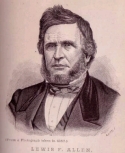
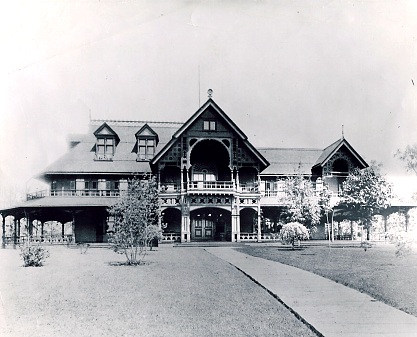
Lewis F. Allen - The Falconwood Club
(Lewis F. Allen) From a photograph taken in 1857 -
Illustration source: "History of the City of Buffalo and Erie County."
Lewis F. Allen is a man well remembered in local history. Born New Year's Day 1800, his ninety years were filled with many and varied interests. In April of 1827, Allen and his bride, Margaret Cleveland, settled in Buffalo, as he had found employment as the secretary and financial manager of the Western Insurance Company. During his lifetime he was instrumental in founding many of the city's civic and social enterprises: the first Board of Health in 1832, the Buffalo City Cemetery now "Forest Lawn" in 1848 and the Buffalo and Erie County Historical Society in 1862. Besides this, while carrying on a highly successful Insurance and Real Estate business, he found time to serve in the New York State legislature in 1836 and later in conjunction with his love of farming, he was elected president of the New York State Agricultural Society. It is in this area, agriculture, that Grand Island is chiefly interested in him. Allen loved nothing better than to be known simply as a farmer and was listed as such in the Buffalo City Directory for many years after his retirement in 1869.
The first agricultural society within the present county limits was formed in 1820. Since Erie County had not as yet been carved out of Niagara, the organization was known as the Niagara County Agricultural Society with Dr. Cyrenius Chapin as its president. However, the society met with indifferent success. Fairs were held at odd intervals, but were eventually given up due to lack of interest.
In 1831, the Buffalo Horticultural Society was formed with Lewis F. Allen as president. It was more or less a revival of the old society. That October a two-day fair was held on the old Court House grounds -- how the site of the new Buffalo and Erie County Public Library. The idea caught on and the Fair which Allen started has been held annually ever since. Allen remained as president of the organization until 1847. The following year he was elected President of the New York State Agricultural Society. It was not a surprising choice, Allen wrote a great deal for the agricultural papers and the Grange Judd Publishing Company, the best known nineteenth century publisher of Agricultural pamphlets and books. As early as 1834, Allen became interested in stock breeding. As the years went by, he began to pay special attention to the development of short horn Guernsey cattle keeping about 80 to 100 head at Allenton Farm, his 800-acre Grand Island estate. In 1846, he began the registration of this breed in his American Short Horn Herd Book, a work of great importance to breeders of that day. In all twenty-four volumes were compiled containing the pedigrees of over 125,000 cattle before Mr. Allen was forced to cease publication in 1883 due to his advancing age. During his lifetime, he compiled and edited a number of valuable books not only on the history, care, and selected breeding of the "Shorthorn" but also on farm management and agricultural architecture. His love of farming expressed itself in many ways. Buffalo, once famous for its shade trees, owes a great deal to Allen's interest in arboriculture. Streets such as Delaware, Elmwood and especially Niagara were planted with shade and ornamental trees as a result of his efforts and due to the interest his own zeal aroused in others of the day.
Allen's love of farming stemmed from and was lovingly expressed in the pride and care he gave to his "Island" property. In 1833, Allen acting as the agent for the East Boston Lumber Company, had bought 16000 acres on Grand Island for what was to become the "Whitehaven Sawmill." Later he reserved 800 acres for himself and Allenton Farm was developed. Originally covering the entire southern tip of Grand Island, Allen created one of the largest and finest farms in Western New York
At Allenton, peaches, pears, apples and grapes were introduced to Grand Island. Soon the techniques employed in their care and cultivation became of interest throughout West New York. Scientific farming was the watchword at Allenton. In the fifty years that Allen owned the property, many changes occurred. Not only did woodland and virgin soil give way to the plow and vine, but also Allen established Grand Island as a playground for the wealthy and social elite of Western New York. In the late fifties Allen subdivided the property and began construction of Falconwood. Accounts of the day call the structure the Allen Mansion but it emerged as a public resort. On Sunday, June 19, 1859, Allen opened the doors of his newly built resort "Falconwood." Named for the eagles and hawks which nested in the giant surrounding trees, it was to mark the first of many resorts and clubs built in the latter half of the nineteenth century.
Allen, in picking a strip of land on the southwestern side of Beaver Island selected one of the most beautiful sites on Grand Island. It was hoped that Falconwood would prove to be a restful retreat for the businessman and his lady. It did.
One of the most handsome structures on the river, its design was of the "villa" order or what would later be known as "Queen Anne" for the lack of a better name. Built entirely of wood, it was a two-story building with steep gabled roofs. Facing the Niagara, its 100 foot length was covered by wide, flossy verandahs. The exterior was painted grayish drab, painted with a darker shade, with the long slant of the roofs a bright red. The front, facing the river, was dominated by a large heavily ornamented central projection almost Moorish in detail. From here, large double doors admitted guests to a broad vestibule and hall in which the great staircase could be seen leading to the second floor. This room, as were all the rooms on the main floor, was paneled in natural wood. The stain glass in the doors and the side windows were executed in shades of amber, brown, red and gold, thus lavishly accenting the natural tones of the wood. To the right of the vestibule was the parlor, 32 feet by 40; to the left the dining room of the same dimensions. Near the end of the central hall were doors leading to the public bathrooms, kitchens, and pantries.
The second floor was arranged so that coming off the stairs one found himself in another large central hall running the full length of the house. Outfitted as a second floor sitting room, its large crescent shaped windows looked out on the riverfront on one side and back to the Falconwood Park and forestlands on the other. Twin halls running parallel to the building's length ended in French doors leading to the second story verandahs. Off these halls the visitor would find his bedroom and bath of which there were twelve in all.
Besides these facilities, the clubhouse boasted one of the grandest bars in Western New York, a bowling alley, an assembly hall and numerous guest cottages separated from the main building. It is thought that the original cost of building and outfitting Falconwood was $13,000.
The resort enjoyed great popularity with the general public prior to and during the Civil War. It was the scene of many outings and family picnics. Each weekend found the establishment packed with crowds brought on such steamers as the "George O. Vail," "Cygnet," "Arrow," "River Queen," and "Fanny White."
An idea of Falconwood's popularity can be seen in an old advertisement taken from the Buffalo Morning Express: "On the following Labor Day weekend, the "River Queen" was scheduled to make three trips a day from her Amherst Street dock to the hotel and back at a cost of forty cents per round trip." This is not a bad record when we realize that Falconwood was still one of the few entertainment centers of importance on the Island and that the nation was busily engaged in a Civil War which was not conducive to such excursions.
These gay and happy crowds ended with the purchase of the resort by W. W. Wood for the "Falconwood House Company" in June 1865. Falconwood now began its greatest era. In the next thirty years it became the exclusive playground of the social elite. Emphasis was on quality and gracious living. It was a rich man's paradise.
Falconwood was imposing even by present day standards. At its heighth, it consisted of forty-five acres in grounds laid out in ornamental trees and flowers. The twelve foot veranda running the full length of the building provided an excellent view of the lawns and wharf which projected 110 feet into the river.
Essentially the house was a resort for the members of the club and their invited guests, offering room and accommodations for extended stays. During the latter part of the century, Falconwood included approximately seventy members, drawn from the leading families in the social life of Buffalo.
Many prominent businessmen made the club their chief resting place during the summer months enjoying the swimming, boating, and fishing which were said to be unexcelled. Each member was allowed two weeks at the club every summer, under the terms of the membership. Many, however, stayed on throughout the warm months. The club's private yacht carried these members to and from their businesses in Buffalo each day. For the most part, the week days were stag affairs. However, Falconwood always welcomed the wives and ladies of its members for the leisurely weekends. Its hospitalities were generously extended on many occasions. Notables from all over the world were entertained there at various times. Men such as John Duke, Lord Coloridge, the noted English barrister and judge, were brought to Falconwood during their stay in Buffalo, as it represented only the very best by Victorian standards.
Near the turn of the century, Falconwood became the property of George B. Matthews of the Courier Express. Under his ownership the house continued to serve as a private club and estate to his family and friends until it was destroyed by fire in the twenties.
Fire was an ever-constant threat on the Island creating fear and dread for all who lived here. Once it broke out, little could be done. This situation becomes apparent when we read accounts like the following on the destruction of Falconwood, taken from an undated and unmarked newspaper clipping:
The operator at the Central Telephone Office received a call at one o'clock this morning from the Falconwood Club House stating that the house was on fire and asking if assistance could be rendered by the Buffalo Fire Department. Fire headquarters were communicated with but it was at once seen that any attempt to render assistance would be useless. The party at the clubhouse, receiving the answer, stated that he could send no more messages as the flames were upon him, adding that the whole house would doubtless burn. The cause of the fire was not "positively known" but is supposed to have originated from live coals placed in ashes in a barrel in the woodshed.
Little remains of Falconwood today. However, if you walk along the shore line to the southwestern limit of the Beaver Island State Park, you will discover an old stone retaining wall and just above a small circular plot of ground around which is a low and rusting chain. This is Matthews children's animal cemetery reflecting with grace the love and sentiment of a bygone age. Yes, nothing is left of Falconwood -- yet its name lingers on in the modern housing development which bears its name.
Sources:
May C. Allen interview Jan. 21, 1963.
Harold Long interview January 30, 1963
Thomas' Buffalo City Directory, Buffalo, New York: Thomas, Howard & Johnson Publishers, 1869
May C. Allen's Scrapbook (Brown & Gold Binding) News clipping.
1947, History of Erie County Fair.
Buffalo Evening Times "Porter-Allen House," March 17, 1909
Grand Island Scrapbook Grosvenor Library, unmarked news clipping, page 14
Centennial, page 42
Buffalo Morning Express, September 3, 1964
First-hand knowledge, Barry C. Burnett
Editor's notes:
• Author Barry C. Burnett - Grand Island, NY resident - graduate of Buffalo State College - B 1941-D 1995
• Lewis F. Allen's son, W. Cleveland Allen, built an early American-style farmhouse around 1873. Used today as the Grand Island Historical Society headquarters, "River Lea" is located in Beaver Island State Park. For a feature River Lea, click "Lewis F. Allen/River Lea"
"Playday" on Grand Island Celebrates End Of WWII, V-J Day - August 1945
Posted August 18, 2005
By Teddy Linenfelser
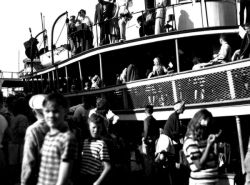
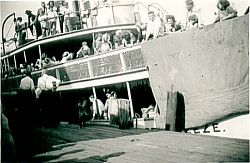
Islanders board Seabreeze for Play Day excursion around Grand Island.
Click photos for larger view.
Cy Gay, proprietor of the Bedell House in Ferry Village, first announced plans for a major Island picnic, "strictly a family affair," in a June 1945 issue of Ollie Howard's Island Dispatch, the Island's new newspaper, just a little over a year old and published every other week. The event was to be the Island's celebration of the end of World War II.
Grand Island Play Day took place on Wednesday, August 22, 1945 and offered a ride on the Seabreeze, "loaded to the rails with ice cream, pop and peanuts for the children," with Capt. Frank F. Fix at the helm.
Said to follow in the footsteps of its predecessor, the Harvest Picnic, an old time community picnic flavor was assured. The committee, under the direction of Chairman John Gast, included Elsie E. Stamler, Mrs. Albert Prentice, Evelyn Rhodes, Alice Wolf, Supervisor Reginald P. Long and Ernest Godfrey. The Seabreeze left the Bedell House dock at 12:30 p.m. for its trip around the Island, arriving back at the dock at 4 p.m. The afternoon featured games for the kiddies such as a peanut scramble followed by a set of games with prizes for children of all ages. Jerry Mahnk and Albert Keppler won the egg throwing contest and the pie eating contest winners (14-16 age group) were Tim Sheehan, 1st; and Paul Stack and Kenneth Webb, tied for second place. Other winners included Cinderella Race – 1st Mary and Vernon Hanna and 2nd, Dorothy Lehane and Vincent Wolf; Nail Driving contest, 1st Dorothy Howard and 2nd, Anna Kneer; Men’s shoe race, 1st Vincent Wolf with Edward Ball 2nd and Charles Wiedemer 3rd; Oldest Married Couple, Martha and Peter Vanthoff; Prize Waltz, Bernie and Bill Dekdebrun; Tallest Lady over 50 years, Mrs. Alfred E. Yensan; Shortest man over 50 years, Eugene G. Bucher; Fox Trot, Oliver Howard and Naomi Loder
A Basket Picnic took place from 6-7 p.m. at which time the Grand Island Volunteer Firemen’s Drum Corps played under the direction of Walter Markle. Supervisor Reg Long threw out the first ball to open the baseball game between the North and South sections of the Island. Co-captains of the North team were Jerry Bocksberger and Jimmy Cummings and co-captains for the South were Johnny Dollhausen and Dick Vampotic. George Whetzle, former semi-pro of Buffalo, served as the empire.
Dancing in the evening was highlighted by a beauty contest judged by Ed Kruse, Bill Kaegebein, Frank Klocke, Ken Winters, Leon Peck, Ted Klingel, George White, Henry Metzler and John Schimmel.
A girl by the name of Eileen Shanahan of Staley Road and Express Highway was named “Miss Grand Island of 1945.” In second place was Island native Lois Killian (Kaiser). The Island Dispatch column, "Across the Mahogany with Willie” included the following note: "All that fuss about the length of time of Miss Grand Island’s residence certainly didn’t help to weld relations between the so-called newcomers and the old timers." The newcomers were mostly Grandyle Villagers who moved to the Island just three years previous.
Included in the Dispatch column, With Dottie on the Partyline, was this note: "‘Tis too bad the rules governing the Miss Grand Island contest weren’t clearer. It would have eliminated the possibility of a non-resident winning the title."
Play Day also featured children's beauty contests. First and second place winners for girls 3 to 5 were Gale Klocke (Sander) and Judy Hanna (Hathaway), and for the boys 3-5 years, David Kean was 1st and Thomas Sheehan, 2nd.
The Play Day trip around the Island was the last excursion for Capt. Fix, and also the first time in years his entire family rode
on the boat, "which all adds up to an appropriate ending to a colorful career," the September 3, 1945 edition of the Island Dispatch reported. Sadly Capt. Fix died at the helm of the
Seabreeze four days later.
Island's Original Bridges Are 70 Years Old This Week - 2005
Posted July 14, 2005
By Teddy Linenfelser
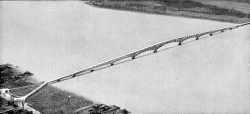

(Left) North Grand Island Bridge with the Niagara Falls terminal on the left. (Right) South Grand Island Bridge connecting to the Island at the lower right of the photo. The photos are part of a 1935 Grand Island bridges brochure of facts including the following: passenger cars 25 cents over two bridges; cost of bridges $3,500,000; length of bridges: north bridge 4000 feet; south bridge: 3400 feet.
The Grand Island bridges opened to traffic 70 years ago, and according to the Grand Island Centennial booklet, printed in 1952, Grand Island's need for a bridge to and from the mainland was apparent as far back as 1819. It was sometime after that that ferry boat service began to operate and serve the people of the Island. The long struggle between then and 1935 when the north and south spans were finally completed, is well documented.
"Town folk and their friends assembled on July 13, 1935 at the town hall where a long procession of automobiles formed." The Riverside Community Band, seated on two flat-bed trucks and under the direction of the late Bill Pinkow, led the procession toward the south bridge, and over to the Tonawandas and through Niagara Falls, then back to the Island over the north bridge to Edgewater Park on the east river shore.
Speakers at the park included Town Supervisor John L. Mesmer, Arthur L. Swartz, Charles Freiberg, Reginald F. Long and Franklin St. John Sidway. Sidway paid tribute to William H. Conboy, a former supervisor who was unable to be present, as the man who worked unceasingly for 37 years to secure a bridge.
A buffet supper was served to more than 2,000 people who attended the picnic in Edgewater Park. Pinkow's band played a concert in the afternoon and a dance band from the same group played for dancing in the evening.
An official dedication by New York State Governor Herbert Lehman took place two days later, July 15, 1935.
A second south bridge was completed in October 1962 and by January 1965, a fourth bridge opened next to the original north bridge.
The late Bill Pinkow, who married the former Marion Alt, served many years as a music instructor in Island schools.
The following additions to this feature were made on August 14, 2005.
Evelyn and Carlton Alt, married June 28, 1935, decided to drive across the
new south Grand Island Bridge for a visit to a photographer on Niagara
Street, Buffalo. Evelyn said it was late in the afternoon and the workmen
"moved a lot of equipment to allow us to pass." Elmer Long was best man and
Lorna Alt was maid of honor and took the trip across the unfinished bridge.
They returned via the ferry that brought them back to the Bedell House
landing.
The following was printed in a Buffalo, NY newspaper in 1935.
Wednesday at midnight the two bridges connecting Grand Island with Tonawanda and Niagara Falls will be opened for Fourth of July traffic and the dream of making the island a more integral part of the Niagara Frontier will have been realized.
Bedell House Saloon - Grand Island, New York - 2005
Posted June 30, 2005
By Teddy Linenfelser
Click photos for larger view
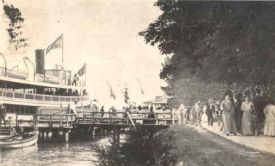
Loading dock for the ferries at the Bedell House, 1908. Promenade on right led from the ferry landing just south of the Bedell House to the Buffalo Launch Club. Click for larger view
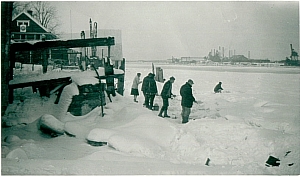
Ice Fishing in front of the Bedell House, 1940s. Click for larger view
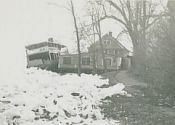
Down-river view of the Bedell House and the Orleans. Heavy river ice caused the ferry to crush the Bedell House pier and the building on March 22, 1955. For feature article and pictures of the Orleans incident, click "Orleans". Click photo for larger view
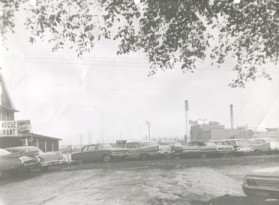
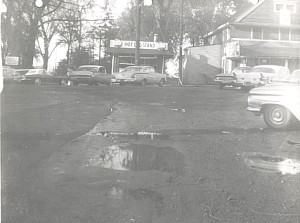
Scene from the 1960s. Click photos for larger view
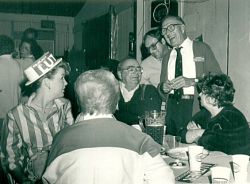
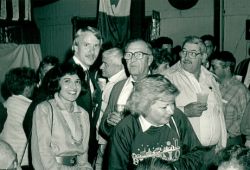
Republican Supervisor Laverne "Bunny" Luther's re-election party in the fall of 1987. Click for larger view.
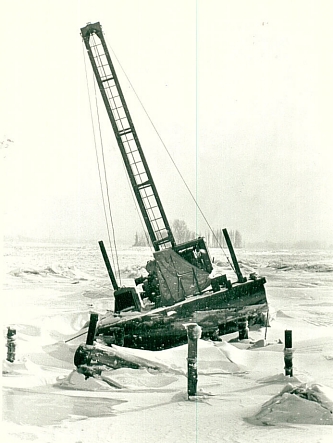
This barge was hung up on river ice in front of the Bedell House in Ferry Village during the winter of 1982. Motor Island is shown in the background.

The steamer "Ossian Bedell" - Click for larger view.
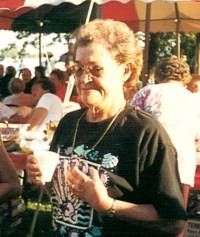
Charlotte Guenther Roesch
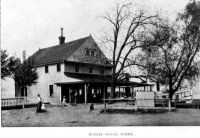

Bedell House Annex 1800s Bedell House Annex 1914
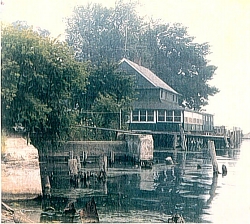
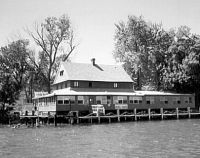
1960s Summer of 1987/Jodi Robinson Photo
Click photos for larger view.
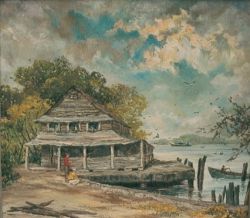
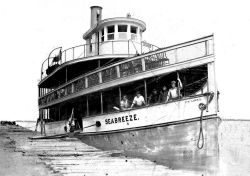

Painting by Gladys Martin - 1950s The Seabreeze The Clarence Fix
Prologue of Personal Memories
My parents, Ted and Marion Klingel, were in the Bedell House annex in May 1945, the night victory was declared in Europe (VE Day) and we have a beer tray liner covered with the signatures of many familiar Island names to prove it. They were also in the Bedell House to celebrate VJ Day (Japan) and reminisced about "half the Island" being there that night.
My own personal memories of being at the Bedell House start at about the age of 3 or 4 and being outside in Bedell Park at an Island picnic, possibly in 1945 - Grand Island Play Day - a celebration of the war being over. Another childhood memory is of playing the bass drum with the band as a 6th grader for a politician friend of our director, Bill Pinkow. From my perspective, everyone, except for the kids and adults in our band, was in a rowdy mood. At 11 years old, I couldn't even imaging having that much fun!
My grown up memories are the best. They are of being excited at the prospects of a good time about to be had. I close my eyes and remember riding down Ferry Road with my boyfriend in his 1955 white Ford convertible and then we were there - looking for a place to park - walking in - let the party begin.
We are riding toward the Bedell House, now married, looking forward to and having a grand time with our now married friends and relatives.
Drifting through memories of living in Ferry Village, we are walking our baby in a buggy and stop by the old tavern where we meet Johnny Gast Sr. and several other old-timers. It's a hot summer day and that old screen door just keeps swinging open to let its guests in and out and banging shut. Listen! I can still hear it now.
And I close my eyes and remember the bicycle built for two, our first joint purchase made as 17- and 18-year-olds, but this memory is later and that of our 8-month-old daughter and nearly two-year-old son in baby seats on each end of the bike. After stopping at the stand for hot dogs, we're inside the tavern where son, Jimmy Jr., meets Charlotte's granddaughter, Carol Eastman, and they play with the pool balls while we enjoy the company and a cold one on another Sunday afternoon.
The expectation of the drive up to this grand old building nearly always matched our good times, be it summertime sing-along times, a Halloween party, a political fund raiser, or even the time we went up there to sit on the porch and talk over the possibility of buying our last boat. How could one not make a favorable decision about buying a boat while sitting on the Bedell House porch in June. We were there that final season of 1987, the year we bought our beloved Teddy Lee houseboat. We made our last run up the river in November and I can still hear "Tony" holler as we left the Bedell House that night, "You cooking your Thanksgiving turkey on that boat?" The Teddy Lee was to be docked at the East River State Dock for the summer of 1988, so much better than our first season in Tonawanda, and we were delighted, upon walking to the end of that pier to inspect the slip, to realize we could sit on the boat and watch for open dock space at the Bedell House. But that wasn't to be. We kept the boat for 17 years but the saloon burned before we ever got the Teddy Lee in the water that season. The Bedell House annex stood over 50 years longer than the Bedell House Hotel and we're thankful for the memories.
Ossian Bedell - 1877-1902
The Bedell House Annex on East River Road in Ferry Village, Grand Island, New York was probably built and opened at the same time as the famous Bedell House Hotel, first opened to the public on May 1, 1877. Grand Island's most famous hotel and the annex, a huge tavern used when waiting for the ferries, was built by
Ossian Bedell. He was born in Vermont in June 1832 and died at age 69. Ossian was educated in the "common" schools of Tonawanda, New York and the seminary at Lima, New York, according to Truman C. White's Our County and Its People - A Descriptive Work On Erie County, New York, Volume II.
The following is from that same volume:
"In 1840 he came with his parents to live on Grand Island, and at the age of eleven began driving mule team for his father on the canal and for nearly twenty years, followed the canal with his father and with boats of his own.
"At twenty-one he owned a farm of his own and began farming, lumbering and boating wood on the Niagara River. In 1874 he was one of the leading men who organized a stock company and built the Buffalo and Grand Island Ferry, which was such a great improvement to the Island."
Ossian Bedell, recognized leader of the Republican party served as supervisor of Grand Island in 1861-62. Rob Roy MacLeod wrote of Ossian Bedell in his Cinderella Island, ". . .a shrewd businessman, the Island's first postmaster and . . . the "Duke of Grand Island."
In an 1899 edition of the "Buffalo Express," it was reported that, "The boat service to the Bedell House will be complete this year. The Silver Spray will leave the foot of Ferry Street, Buffalo on weekdays at 10:30 a.m. and 2:30 p.m. and 5:30 p.m. On Sundays and holidays she will leave Ferry Street at 10:30 a.m. and 2:30, 4, 6:15 and 8 p.m. and Hertel Avenue fifteen minutes later. There will be good music at the Bedell House on Saturday nights, the last boat on Saturday nights leaving the Bedell House for Buffalo at 11 o'clock. All holidays will be observed by Duke Ossian (sic) and special preparations have been made for Memorial
Day and the Fourth of July." The reference to the Bedell House could have been for the hotel or the annex.
"Bedell's New Steamer" was the headline in the February 3, 1901 edition of either the Illustrated Buffalo Times or the Illustrated Buffalo Express (clipping cut off). According to the story, "A fine new steel steamer will be built by the Buffalo Dry-Dock Company." The price was to be $25,000 and the steamer, to be built for Ossian Bedell, would be 100 feet long, with a 29-foot beam and 9 feet depth of hold with a passenger capacity of 650. The boat's commission coincided with the opening of the Pan-American Exposition in Buffalo and service would include frequent runs to the Bedell House. At the time of the article, the Silver Spray was the boat of transportation between Buffalo and "Bedell House Landing." The Allenton, a steam yacht, also spent many years on the river bringing people from the mainland to the Bedell House Hotel. The Allenton was described as the fastest and safest in existence and was piloted by Capt. Sam Staley. Other ferries operating from the Bedell House in the early years were the Canadian, the Americana and, of course, the "Ossian Bedell," that made its first trip on May 20, 1900 (see photo above).
Capt. Frank F. Fix (1920s-1940s) - Grand Island Fix Brothers - Steamers
Capt. Frank F. Fix, who played a large part in the history of the Bedell House Annex, was born in 1868 and moved to Grand Island at the age of five.
Frank and his brother, Charles, bought the Bedell House Hotel and annex and all of the property around 1920. The brothers operated the Ft. Erie ferries and excursion boats, running trips around Grand Island in the Edgewater and the Seabreeze. Because of its location as a ferry landing on the Niagara River, the Bedell House Annex was a successful speakeasy during the Prohibition era. Liquor, brought across the river from Canada, was hidden in trucks and cars, loaded on the ferries and taken to the mainland.
The Fix brothers, who, at one time had steamers leaving Amherst Street, Buffalo, always included a stop at the Bedell House. Frank had made 29 trips around the Island as late as 1945, but did so only because he owned the boats and docks. According to Frank, it was just a 'sideline' with him.
Among the finest boats the Fix brothers operated were the Silver King which was their first boat and also the Clarence Fix (so named for Frank's son nicknamed "Paddy"), and the tug, Henry Koerber, which with the barge, Lottie Koerber, was involved in the Eagle Park disaster on the West River in 1912.
The Seabreeze, launched in 1909 in a Niagara Street, Buffalo shipyard, and owned by Charles and Frank Fix, had an original capacity for 600 passengers, later lowered to 300 due to stricter maritime safety codes. The Seabreeze ran for several years between the foot of Ferry Street and the Bedell House and ended its career on regularly scheduled trips around Grand Island. The Fix Brothers sold it in 1947.
Capt. Frank F. Fix died of a heart attack at the helm of the Seabreeze as it left the Amherst Street pier on a Sunday afternoon (August 26, 1945) for a pleasure cruise around the Island. He is buried in Whitehaven Cemetery. Most of the information on the Fix Brothers was printed in a 1951 Buffalo Evening News story (no author).
John P. Mayer Sr. - Clem Scheuerman
John P. Mayer Sr. ran the Bedell House annex for a number of years. A photo above, circa 1914, includes his name on the Annex. This was a postcard with reference to the "Bedell House Landing," as it was known for many years before the bridges.
Clem Scheuerman, who worked for Ossian Bedell for a time, eventually rented the Bedell House annex from the Grand Island Fix Brothers during the depression years, and operated it while living upstairs. He had also operated several similar establishments including one at Baseline and Love roads and another, now the East River Fishing Station near the site of the Bedell House.
Excitement hit the quiet, little Ferry Village in February 1936. According to a newspaper article, "Mr. and Mrs. Clem Schuerman’s Ferry Annex (the Bedell House) was ransacked Monday morning (February 17, 1936). A large quantity of liquor, beer, cigars and cigarettes valued at between $40 and $60 was taken. Constable Lyle Finch rounded up the major portion of the loot under the Rose Cottage (still standing across from the Village Inn) and nearby hiding places.
Bridges Open - Bedell House Hotel Destroyed By Fire - 1935
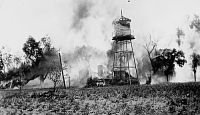
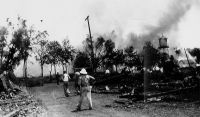
Bedell House Hotel Fire - Click photos for larger view
It was on June 30, 1935 that the famous Bedell House Hotel
was destroyed by fire, leaving the annex to be known as "The Bedell House." Fortunately, it had not operated as a hotel in several years. The late Cy Diebold often reminisced about that
morning when he was attending Mass at Mary Star of the Sea Church in Ferry
Village and the "clang" sounded, notifying area residents of a fire. With no
organized fire company, companies from the mainland drove over the new South
Grand Island Bridge, not yet open to traffic, to offer assistance with the
by then completely out of control fire.
Cy Gay was the new manager in December 1944 and in 1945 Cy was still listed as manager with Maude Fix, the proprietor. In 1945 Jeannie Balas was running the bar on Sundays, along with Frank Klocke, pinch hitting as the singing waiter. Jeannie operated the Bedell House some time after that. Lou Meyer, took over in 1952. He ran and lost the 1954 election of Little Mayor of Ferry Village to Henry F. Mager (Mager's Grill, now the Village Inn).
The popularity of the Bedell House Annex and Ferry Village was some what diminished with the opening of the Grand Island bridges in 1935 and the necessity of the ferry boat a thing of the past. However, people were still coming to the area to rent cottages in the late 1930s and 1940s. Ferry service was resumed for awhile in 1943. The 90-foot, steel tug, Clarence Fix, was eventually sold by the Fixes to a Philadelphia concern. It's been said that some of the boats lie in the graveyard off the Bedell House, including the Henry Koerber, the 20th Century, the Stanley, Franklin and Silver Spray. A few of these were salvaged for scrap during World War II.
During the World War II pleasure ban on power boats the Mercury Power Boat Club sponsored a speed
boat regatta at the Bedell House on Sunday, June 4, 1944 when racers included Islanders Paddy Fix, Dick Voight and Ollie Howard. The boat races continued every other Sunday off the Bedell House. Paddy Fix, owner of the Bedell House annex, took back the general operation of the place in October 1944.
Charlotte Sayles Guenther-Roesch - 1940s-2001
Charlotte Sayles' involvement with the Bedell House dates back to the late 1930s or early 1940s. In 1945 Charlotte was referred to in the Island Dispatch as "the waitress with the flying feet at the Bedell House" who hoped to live on Grand Island some day. She married Anthony Guenther Sr., also employed there and they became Bedell House managers around 1962. Charlotte continued to work at the tavern while taking care of her sick husband. Maude Fix sold the five acres of valuable riverfront property, which included the tavern, the hot dog stand and other buildings, to the Guenthers in 1970 for about $60,000.
With the war over, the Bedell House was being redecorated and the back room remodeled for dancing in 1948, and in 1949 the popular and newly added nightly bingo at Bedell House Park was drawing a crowd. Amusement rides known as "Grandyle Beach Rides" were added in Bedell Park and featured "kiddie" rides beginning with the Decoration Day weekend. The Bedell House was also advertising a dance hall that would bring back memories of the old days when the place was in its hey day. That new enterprise featured "Starlight Dancing" with well-known bands. According to an Island Dispatch report in June 1949, "Mike Meyer was doing a good job of dispensing 'giggle fluid' at the
Bedell House bar. Some damsel told us that he was the best looking
bartender on the Island."
In September of that year boat races were held off the Bedell House to benefit boat racer Al Bingham who was seriously injured in the 1949 international regatta held at the Buffalo Launch Club.
Halloween parties at the Bedell House remained popular throughout its history and in 1950 Carl Anderson, Marion Schnitter and Kenny Maurer were in a three-way tie for first place, best costumes.
Horse-shoe matches became extremely popular at the Bedell House in 1951, especially the mixed doubles matches. It was in January 1951 that Dorothy Merrill (Lovelee) took the honors in a somewhat heated tournament. In March of that year, Charlotte Guenther (Roesch) and Jeannie Flynn won six straight games of horseshoes at the Bedell House.
The Bedell House was under the new management of
Louis P. Meyer in February 1952.
Niagara River ice threatened the destruction of the Bedell House in 1955 when the "Orleans," moored at the Bedell House pier, was crushed against the building. Click "Orleans/Bedell House Feature" for separate story.
Boat racing off the Bedell House became a reality again when the new Grand Island Boating Association held a regatta there in July 1959. Possibly the last of the annual inboard and outboard boat races, sponsored by
the Island Boating Association, took place Sunday, August 12, 1962 off
the Bedell House dock. Winners were Islanders Terry Pinzel in first, Jim Hartman in 2nd and
Jerry Livingston in 3rd place in the BU (B Utility) event. Among other
local racers were Dennis Yakam driving "The Menace" and Rollie Radder racing
his "Red Fish."
The Sidway School 9th grade
graduating class of 1961 held a 20th reunion on August 22, 1981 . The place? The Bedell House, of course!
Excitement was high in Ferry Village in the August 1983. Burglars who
broke into the Bedell House about 6 p.m. Monday, August 22, 1983 were
spotted by owner Charlotte Guenther as she made a routine check of the
closed tavern. The burglars, upon seeing the arriving Sheriff's deputies,
ran into the woods. Deputies pursued the thieves over fences and through
heavily wooded property toward Beaver Island State Park during the two-hour
chase. Village residents assisting in the capture by chasing the bandits on
ATVs and cars, eventually cornered them. "Sheriffs Give Ferry Villagers High Praise" was the local weekly's headline.
Many political rallies were held at the Bedell House and in its later years it also served the Democrats as their election results headquarters. County Executive Edward Rutkowski was an honored
guest at a campaign rally for Supervisor LaVerne "Bunny" Luther (1983) when nearly 300 people came to the Bedell House to show support for Supervisor Luther's re-election bid and hear Don Burns
at his ragtime piano.
A mainstay behind the bar was Charlotte's son, Tony, who worked the crowd for about 10 years. The mother/son team was well-liked and knew just about everyone who came in the place. According to information in an article by Gazette staff writer Melody Cooke, the clientele was most often more off-Islanders than home town folks, proving the fact that from the time of transportation by ferry to the night the placed burned, people continued to cross the Niagara to get to this landmark fun spot, the Bedell House Saloon.
The following was written by Gert Gay who lived in Ferry Village for many years:
"Ossian Bedell built the annex (date unknown) for the 'working man.' The locals dubbed it 'the poor man's saloon.' There is no formal history of the building but from talking to old timers it must be one hundred years old or more. The 20-foot bar was built of solid Honduras mahogany and was often the subject of conversation especially with newcomers."
Fire Destroys Bedell House Saloon - 1988
The Bedell House Saloon burned on March 28, 1988. It had been open that Palm Sunday evening, and the first alarm was sounded in the last remaining minutes of that day. The building, fully involved when Island firefighters arrived, was one of the worst fires fought by the then 50-year-old Grand Island Fire Company. Firemen were called back to the scene time and again Monday and Tuesday and remained on duty in crews all Tuesday night and Wednesday. Rekindling was due to the unusual structure of the century old building, constructed on pilings over the riverfront. This was the only fire involving the Bedell House annex, and estimated damage to the landmark was set at $200,000.
Before the sad demise of the Bedell House Saloon, summer Sunday afternoons found many a boater out in the river waiting and watching for a spot to tie up at the Bedell House pier. The old hot dog stand is still there, just as it's been for about 125 years. After the landmark burned, Charlotte continued to run the hot dog stand and keep the memories alive until her death in July of 2001. That same "Village Hot Dog Stand" has been opened again by Barb Long Zafuto and her sister, Sharon Nichols, for the summer of 2005.
After the fire destroyed the tavern, Charlotte's son, Tony, formed the Anchor Club, a private boating club on the property with headquarters in a building nearly as old as the Bedell House itself would have been. Like his mother, he passed away after a battle with cancer on
October 30, 2003.
The Bedell House was a very special and well-loved place throughout its history, a place that saw many bridal showers, a few weddings, political rallies, New Year's Eve parties, harvest picnics, church picnics and 50s dances. Music of every era filled the air, be it the small dance band of guys like Johnny Gast, or the piano players who so enjoyed playing to the Bedell House crowd. Ragtime and rhythm and blues never went out of style and some of the best was played by Vern McGynn (1950s), Charlie Westfield (1960s-70s), Don Burns (1960s-1980s), Steve Radecke (1970s),
"Frankie G" Gulino (1970s-80s), Dennis Barster (1975-1990), Keith Manson (1980s), Bill Fenlon (1980s), a lady boat guide named Bea Roetzer and many more. When the piano was 'playin,' the crowd was singing and folks were adding their own accompaniment with the spoons, the devil's fiddle (a tambuorine contraption!) and the old washtub bass.
The historic marker commemorating the original Bedell House Hotel (1877-1935) also points out the site was formerly the Island's main ferry landing, discontinued when the bridges were put into operation. Part of the ferry landing remained in front of Charlotte Roesch's Bedell House until it was demolished by ice floes in early spring around 1978.
The Bedell House Saloon was a place that preserved the era of ferry boats, days gone by, and a million happy memories for many of us.
Additional photos and information may be added to this feature story as it is submitted.
Isle Taverns Of The Good Old Days, Grand Island, NY - 2005
Click photos for larger view
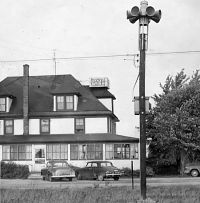
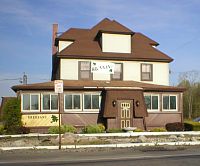
Del & Herb's Grand Island Grill, 1954 and (right) Brennan's, as in "Jon Brennan!"
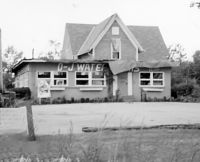
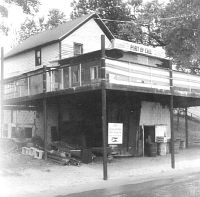
Idle Hour Inn, burned May 2000 Turners Port Of Call, East River at Colony Road

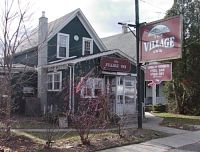
The famous Bedell House annex, burned in 1988 - Village Inn, Ferry Village.
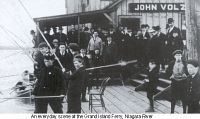
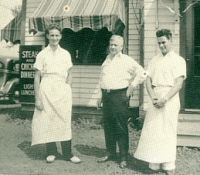
Volz Tavern McNamee's Grill (Richard, Nemo, and Daniel J. McNamee) now known as San-Dee's Pub
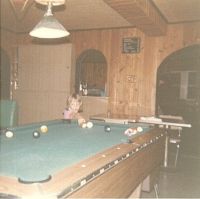
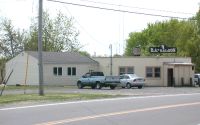
Ceil & Chuck's back room looking toward the bar, 1974 and B.A.'s Saloon today
By Teddy Linenfelser
In recognition of the month of May - National Tavern Month
Taverns on Grand Island have been a booming business for as long as anyone can remember and have stayed in business in some cases for over 60 or 70 years, changing hands due to old age or illness for the most part.
One of the oldest in town is the former Cathy & Jim's on Love and Baseline roads, originally built as Maccabees Hall, midway between Love and Staley roads before the turn of the century. The building, also known at that time as Amity Hall, belonged to members of the Maccabees, the Fraternal & Benevolent Policy Holders in the Maccabees Life Insurance of America, a farmers' alliance of insurance which was started on the Island around 1890.
Eventually the building was moved closer to Love Road by the New York Central Railway and again, to its present location and opened as a restaurant in May of 1936 by Clement Scheuerman. Clem previously operated another Island tavern, which eventually became Davern's Tavern (now the Niagara River Station Fishing Club) on the East River in Ferry Village. It was Scheuerman who added the porches to the east and south sides of his new place.
The longtime favorite eating place, has had a total of four owners in its 69-year history including Siegried (Ziggy) Gromm, Del and Herb Haller and present owner, Ilona Lang. The Haller twins purchased the restaurant and opened it as Del & Herb's Grand Island Grill in 1947. The brothers expanded the dining facilities including the addition of a private banquet room, and were followed in the business first by Del's son, Del Jr., and later by David and Margaret Ann Haller, son and daughter-in-law of Del Haller Sr.
The first-rate eatery with the horseshoe-shaped bar, owned by Mrs. Lang since 1993, closed in 2003, and was opened as Brennan's Restaurant under the partnership of Lisa Duchscherer and Jon Brennan in August 2004. Food is of excellent quality and the Sunday brunch, a bargain at $9.95, offers a buffet of fresh fruit, pastries, salad and fruit juices accompanying entrees running from eggs benedict to grilled salmon. (Editor's Note: Brennan's closed in June 2005)
Sand-Dee's Pub at Elmwood and Ferry roads has been a favorite "watering hole" for over 75 years. The present owners, Sandy and Dave Dee, assumed ownership in 1987 and added horseshoe pits and an outdoor patio. Originally owned by a woman named Belle Johnson, the property, including this vacant building, was purchased by Albert "Nemo" McNamee during prohibition in 1928. Nemo, father of the late Richard and Daniel J. McNamee, ran it as a speakeasy and sold "booze" to the local clientele until prohibition was repealed. It was at that time that he added to the building, piece by piece, and established McNamee's Inn, drawing a good crowd of folks from on and off the Island. This was when off-Islanders gladly traveled here by ferry boat.
Marge Lyden, who eventually became Nemo's daughter-in-law, ran the business until his sons returned to the Island after World War II in 1945 and took over the operation. The spot was renamed the East River Grill and operated by Chris Sorensen in 1944 and back in the hands of Dan McNamee in 1945-46. In the spring of 1947 Josephine "Josie" and Charlie Dauscher were at the helm and in 1948 the place looked like new again when new owners Eleanor and John Sugier gave the place a coat of white paint with red trim.
Charlie Ahr bought the property in 1965 and ran the place until he died. Even the non-bar hoppers couldn't resist stopping in to see the "300 pound go-go dancer," highly advertised by Charlie in the late 1960s.
Sand-Dee's, where live bands have been featured in the past, has a large following of regulars throughout the year along with a constant influx of visitors both young and old.
The Village Inn on Ferry Road, not far from the East River and owned and operated by Mike Carr since 1988, is one of, if not the most popular restaurant on the Island. Bar keep Dave Dulak has been a big part of the atmosphere almost from the beginning.
Johnny Mayer acquired what had been the Ira Johnson home, enlarged the front and opened it as a tavern the night the Bedell House Hotel burned down and just prior to the opening of the Grand Island bridges in 1935. To accommodate its popularity, he built the porch on the east side the following year. Johnny, who ran the place until he died in 1953, was the son of John P. Mayer who formerly ran the Bedell House annex, a locally famous tavern, and a story in itself*.
Henry and Helen Mager took over, installed central heating and eventually sold it in 1962 to Marge and Ray Lippens. Marge continued to run "Lippens Grill" for about 25 years. The old, round "Bevador" beer cooler still stands in the corner of the Village Inn's bar area where beverages are kept cold just as they were when Ferry Village was in its heyday. And patrons keep coming back to this charmer which really hasn't changed very much through its four owners over the past 70 years.
Turner's Port of Call overlooking the East River at Colony Road, was purchased by familiar boat racing enthusiast Thomas G. Turner and has been owned by the Turner family since December 1965 when the place was named Turner's Riverview Inn. It is quite probable that the property was originally the site of a tavern/restaurant called Volz's run by John Volz (not to be confused with William Voetsch of Edgewater Park fame) and referred to as a summer resort around the turn of the century.
Joe Martene operated the present building from 1918-1941. It was "Joe" who added the verandah and a boat house in 1936. Martene's father and grandfather operated an ice house on the same property. Helen and Frank Bailey then ran it as Hunter's Restaurant in 1944. Jean and Stan Kreher took it on in the spring of '45 naming it Kreher's Restaurant followed by the Elsaessers (Nell and Neil Benner Elsaesser) in 1948. Thelma and Bob "Bud" Zurbrick had it from 1954 to 1963 and then, for a short time, it was called Gatke's Riverview Inn until Tommy Turner purchased it, and eventually changed the name to Turner's First Turn Inn.
Now known as Turner's Port of Call, this summer place with docking facilities, a huge outdoor patio overlooking the river, and famous for its steak sandwiches, is run by the late Tom Turner's son, Don.
Glen F. Simons owned the property which was the site of the former Idle Hour Inn, last known as D. J. Waterworks and located just north of the south Grand Island Bridge. Originally a farm house, it is believed to have been built by a man named Fremont H. Simons who came to the Island with his parents in 1863. The acreage on Lot 32 was known as The Glen, as shown on a 1909 map of the Island. The Fremont Simons farm was north of Brighton Beach (Map 1893) and in the immediate area of School House #1.
Johnny Roach was the well-liked operator of the place in the 1930s and 40s when new Grandyle Village residents found it and Ziggy's at Love and Baseline much to their liking during World War II when gas was rationed and a walk to the tavern and back was not unheard of.
Early in its history as a restaurant/tavern it was referred to as the Idle Hour Inn, named after a steamer built in Buffalo in 1893 and measuring 140x32x10. The Idle Hour plowed the river from Buffalo to Electric Beach (approximately 2328 East River Road) on the east side of the Island. At one time a painting of the steamer (circa 1894 by artist "Rudolph") could be seen inside the restaurant.
In 1945 Peter and Lillian Carpenter and Lil's father, John B. Heusinger, took it over and it continued to be a very popular eating and drinking establishment. The Carpenters enlarged the place by adding a kitchen and a room on the back, but purchasing the property at that time was nearly impossible, perhaps due to the fact that the site was part of many acres of land owned by the New York Central Railroad who would not subdivide.
Marty and Jo Schwagler operated this eatery with the long bar from 1950 to 1954, followed by Bowman Otto. It was referred to as Bo's or Bo Otto's Idle Hour Inn for at least a decade. Jim Donlon's Idle Hour Inn was being advertised in the local weekly paper in the summer of 1960.
The Idle Hour had numerous owners/proprietors and names over the following years, including "Brothers" (Jim and Mike Malaney), River Vista (Ed Lewis, 1978), the Shipwreck & Cargo Company (Chris and Louie DePerro, 1980), River Port Inn (1982), and lastly D. J. Waterworks, so named by John Smith, who opened for business in the mid 1980s. The building was closed for business when it was destroyed by fire in May 2000.
A grand opening of Ceil and Andy's Restaurant, originally a perfectly round building on East River at Colony Road, took place in the spring of 1948. Ceil and Andy Alt built the spot with the lumber from the dismantled School #5, the second school by that number located at Bush and Baseline roads. Andy built the place with the help of his brother-in-law, Fred Group. Oldtimers will remember Evelyn "Evie" Rankin, Andy Alt's sister, who was the main cook for many years.Ceil's son, Chuck Carter, became partners with his mother after Andy's death, and the "round house" was then known as Ceil and Chuck's.
When first sold, around 1977, it was known as Von's, followed by Z's Island Inn and as of May 25, 1984, it became B.A.'s Saloon, owned and operated by Billy Aydelotte.
New kid on the block is the Brick Oven, formerly St. Angelos, and featuring a long bar in its lounge, new decor throughout as well as an outdoor patio. Judging from all reports, this is where adults of all ages are stopping by after a meeting or off-Island entertainment, meeting friends, or just hoping to meet someone new. Brick Oven is located at the south end of the Grand Island Blvd. plaza and serves a good breakfast, lunch and dinner in the dining room.
The popularity of taverns has changed over the years. The days of tying one on in the local saloon only to end up in the ditch are behind us. Tough enforcement of laws and changing social attitudes have placed designated drivers behind the wheel in most cases, and cocktailing where driving is involved has been minimized, and for many, has come to a screeching halt.
With record players somewhat of a rarity in private homes during the 1930-40s, jukeboxes were a great source of entertainment to the patrons of these friendly meeting places, along with indoor and outdoor horseshoe pits, shuffle boards and eventually pinball machines. The biggest drawing card in 1948 was the television and the first taverns to have this miracle of miracles were Roy Trautman's place (Isle Inn) on Baseline and Staley roads and Kreher's - now Turner's. The Isle Inn was destroyed by fire March 19, 1968.
Entertainment in these same places today includes pool tables, video games, Quick Draw, dart boards, as well as the proverbial jukebox filled with CDs instead of 78 rpm records and, of course, big screen television.
The patronage of the Island's establishments, which also include T.C.s Lounge (Chris Stedman), the Pepper Mill (Larry Braddell), and Town Cafe (Leonard Alessi), all on Grand Island Boulevard, is certainly not what it had been before the smoking ban and the popularity of certain places has changed. For one thing, the percentage of those who just stop by for a few cocktails or an evening at the bar is much smaller. However, the local "taverns" are still in business and most seem to be keeping pace, especially at this time of year. A good spring and summer weatherwise is always good for business. Cheers!
*Bedell House Hotel and Annex story coming soon!

























































